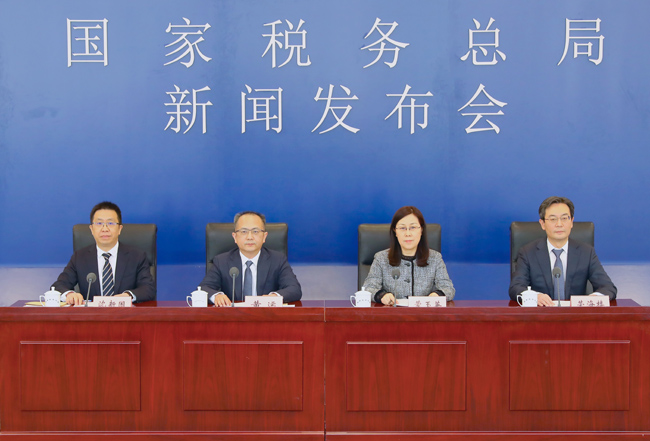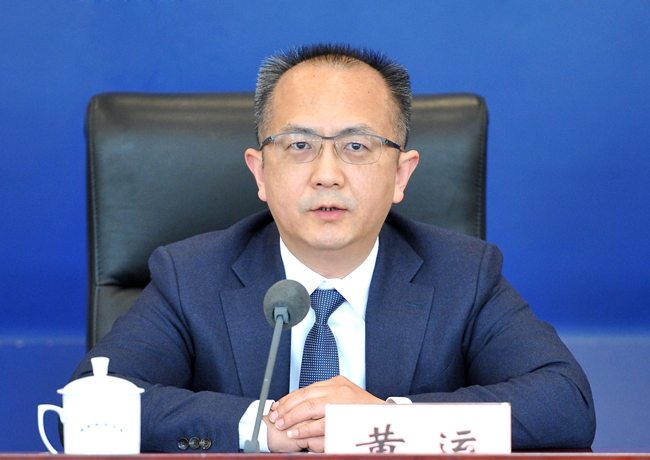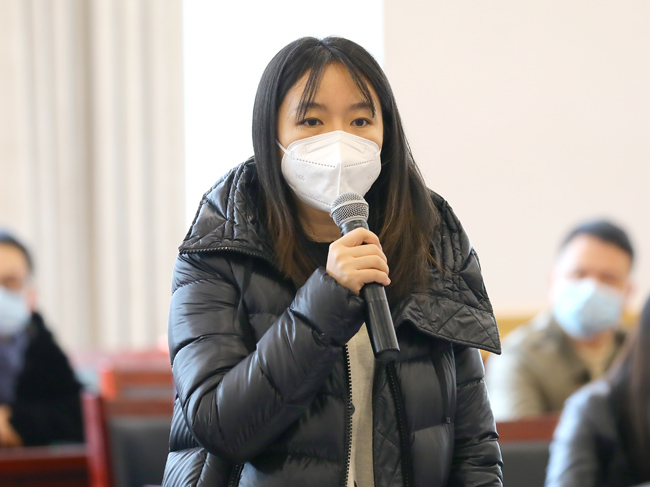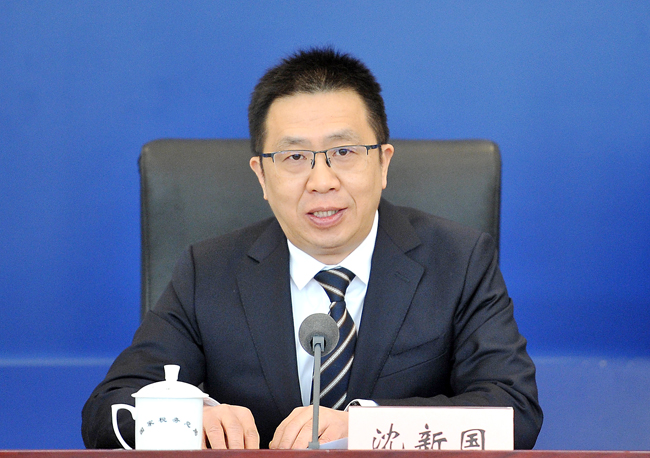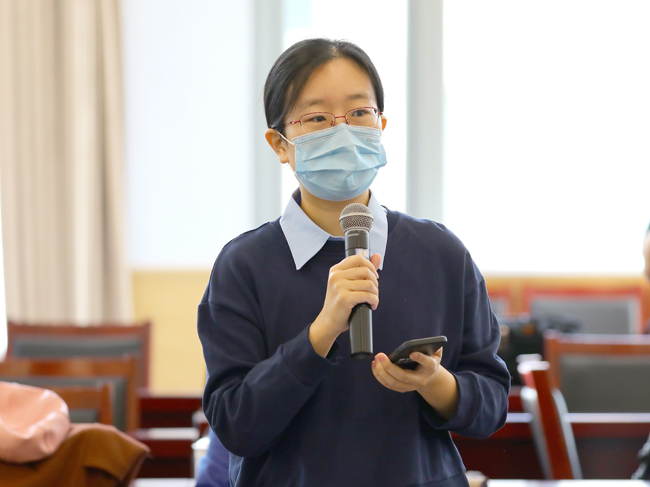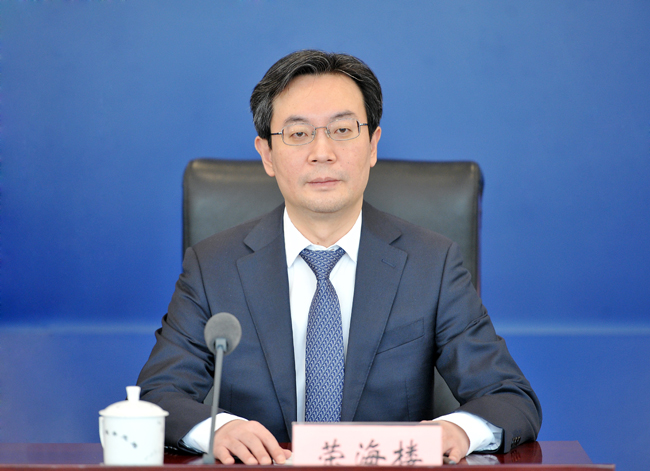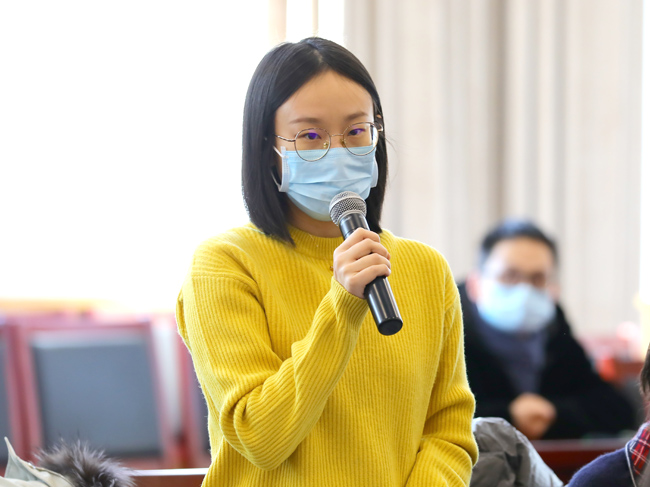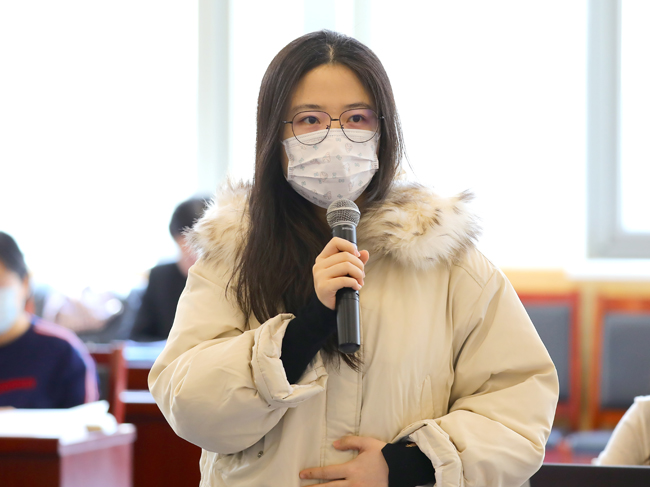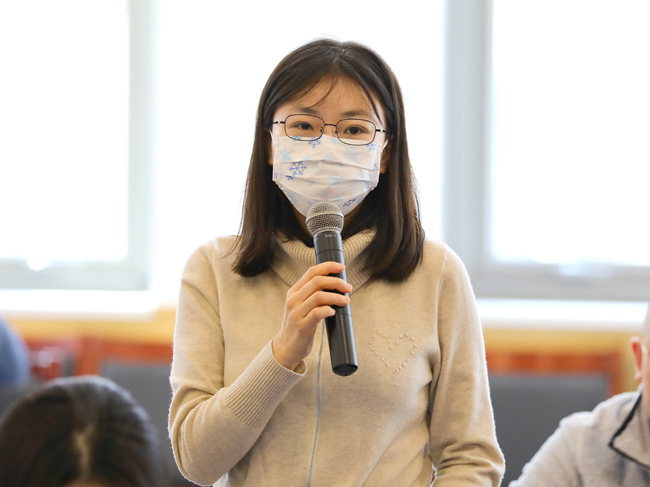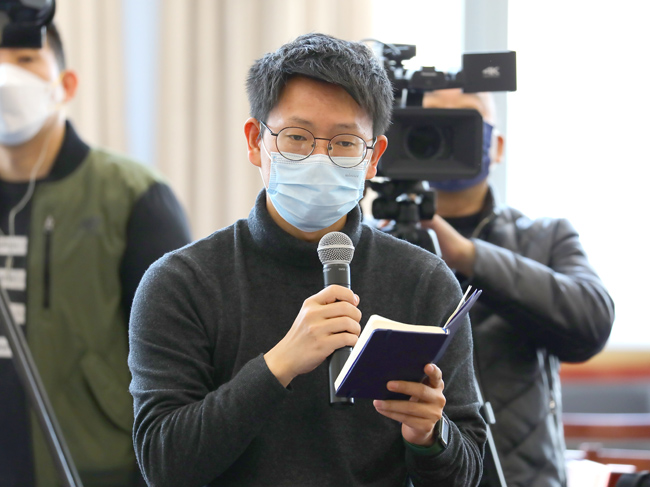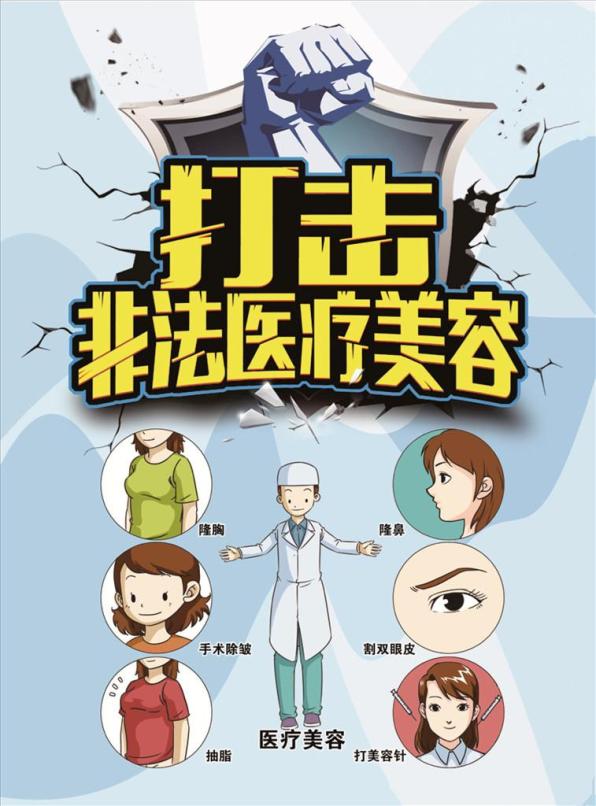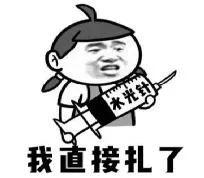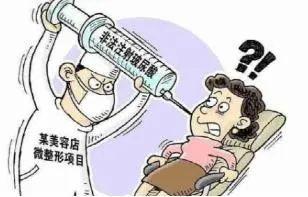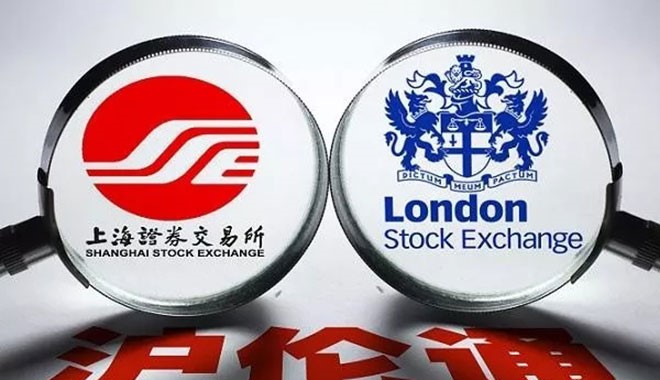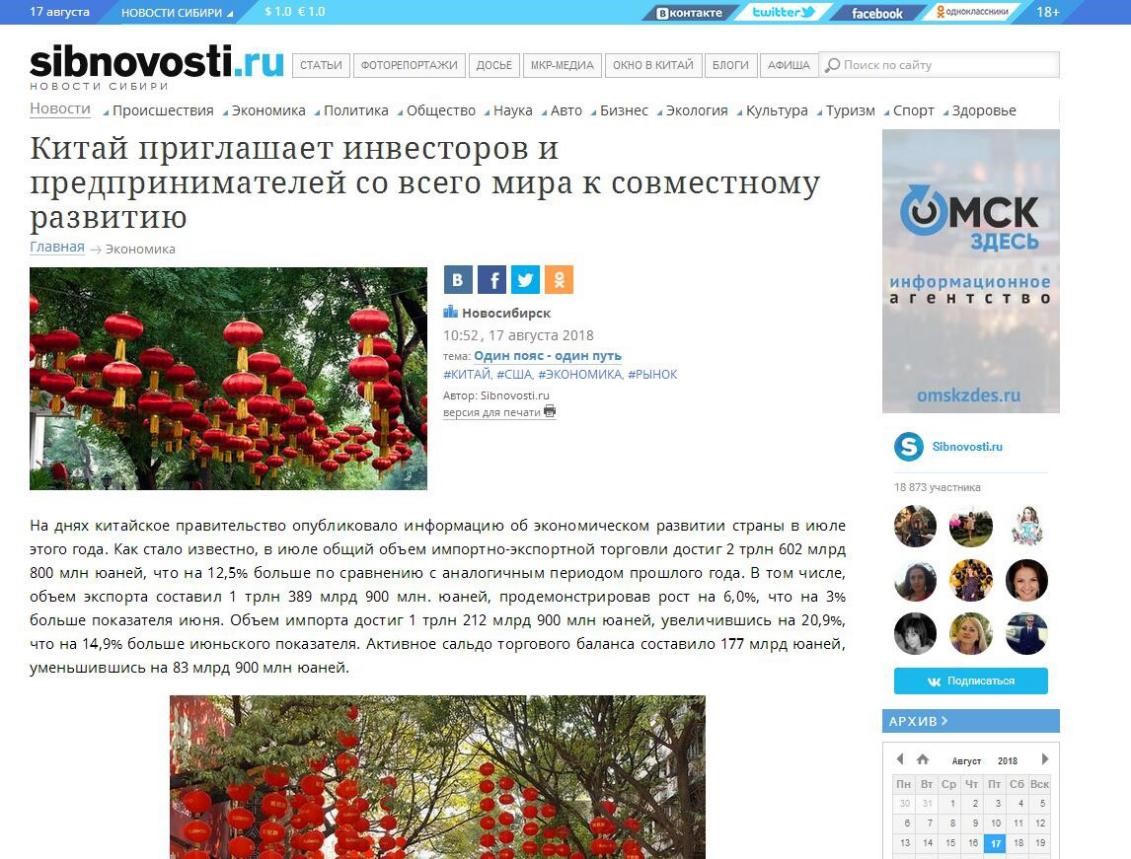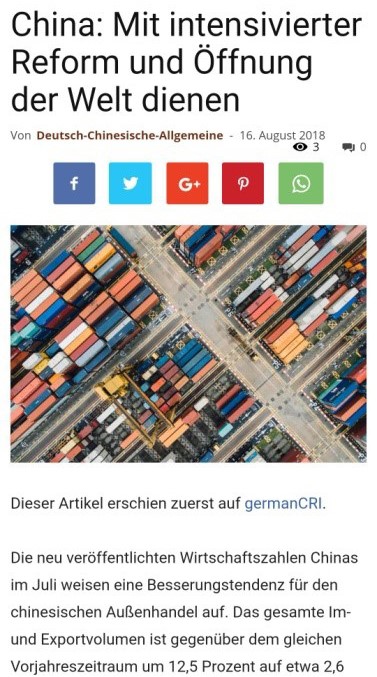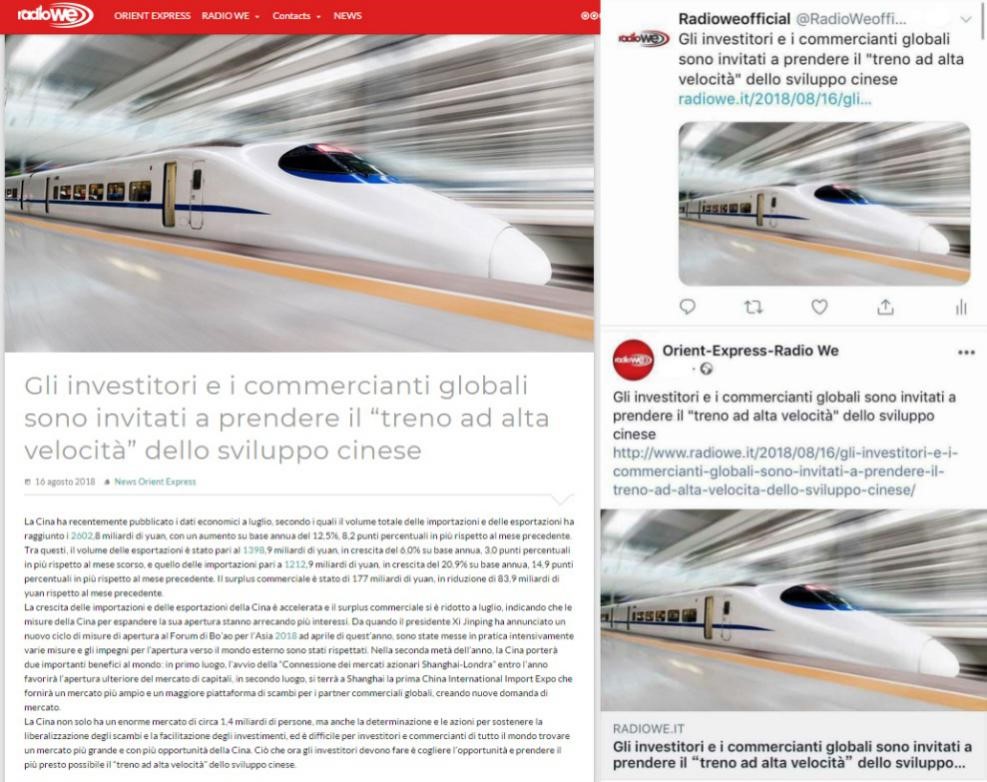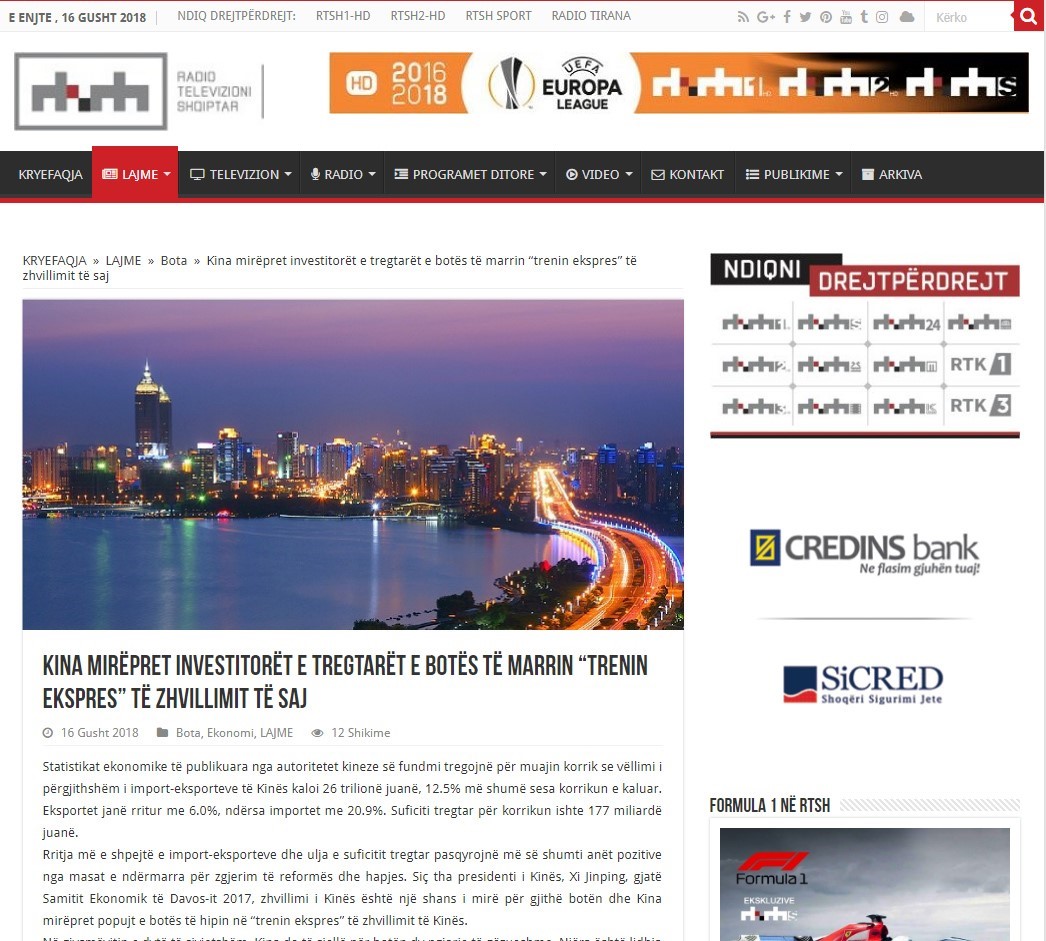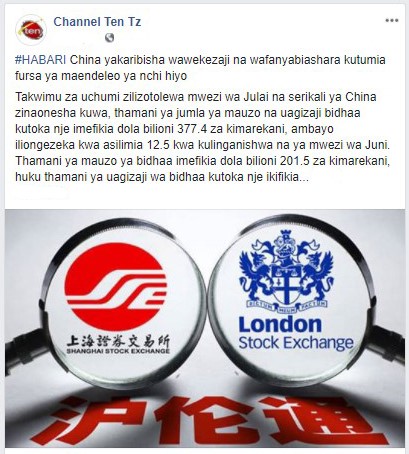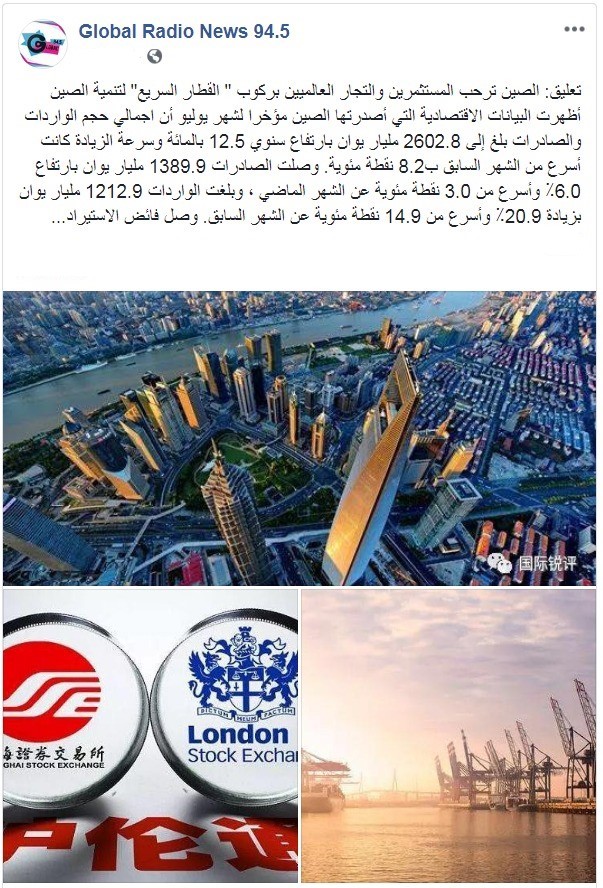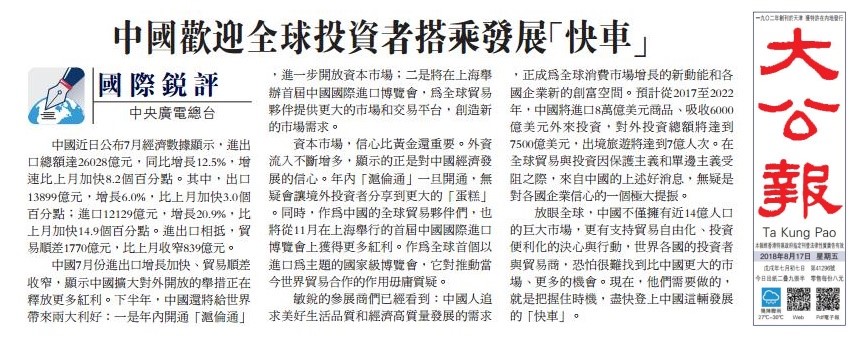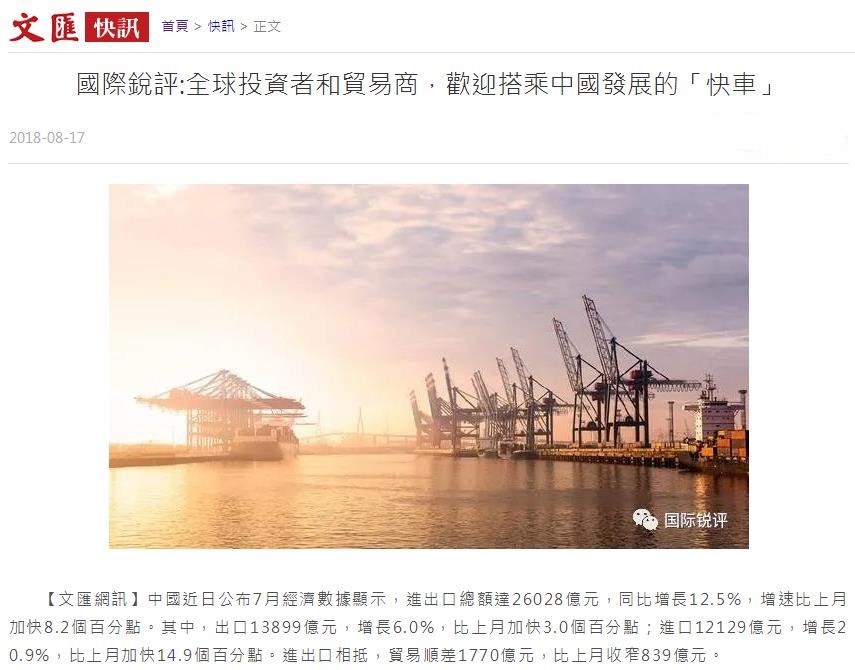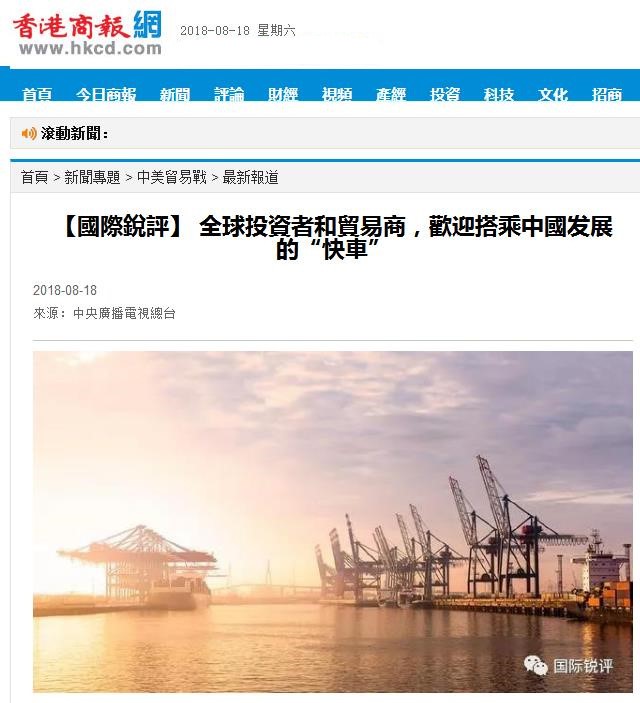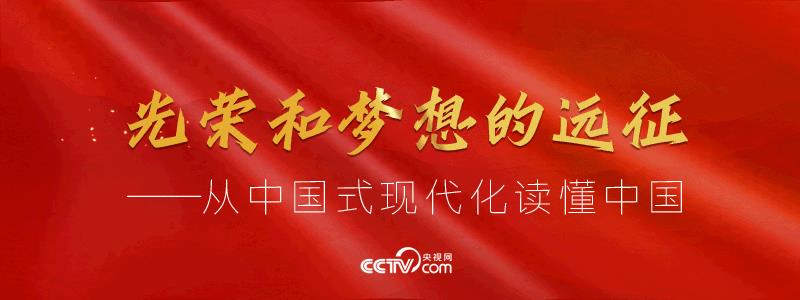Notice of the General Office of Guangzhou Municipal People’s Government on Printing and Distributing the Thirteenth Five-year Plan for Energy Conservation and Carbon Reduction in Guangzhou (2016-2020) Sui Fu Ban [2017] No.15
Notice of the General Office of Guangzhou Municipal People’s Government on Printing and Distributing the Thirteenth Five-year Plan for Energy Conservation and Carbon Reduction in Guangzhou (2016-2020) to the people’s governments of all districts, departments and directly affiliated institutions of the municipal government:
The 13th Five-year Plan for Energy Conservation and Carbon Reduction in Guangzhou (2016-2020) has been approved by the municipal government and is hereby issued to you. Please earnestly organize its implementation. Please report the problems encountered in the implementation to the Municipal Development and Reform Commission and the Housing and Urban-Rural Construction Commission.
The People’s Government Office In Guangzhou
April 17, 2017
The 13th Five-year Plan for Energy Saving and Carbon Reduction in Guangzhou
(2016-2020)
Catalogue
The "Thirteenth Five-Year Plan" period is a crucial period for Guangzhou to implement the national "four comprehensive" strategic layout and the "five in one" overall layout, consolidate and enhance its status as a national central city, and lead the province to achieve the goal of "three orientations and two firsts". It is also an important stage for building a low-carbon city in an all-round way and striving to achieve the peak of total carbon emissions. This plan is based on the National Climate Change Plan (2014-2020) and the Outline of the Thirteenth Five-Year Plan for National Economic and Social Development in Guangzhou, and it is the action program for Guangzhou to promote energy conservation and carbon reduction and realize green and low-carbon development in the next five years.
Chapter I Development Status and Facing Situation
Since the Twelfth Five-Year Plan,In accordance with the requirements of the state and province, Guangzhou regards promoting energy conservation and carbon reduction as an important starting point to promote scientific development, actively explores new fields and mechanisms of energy conservation and carbon reduction, and pays special attention to energy conservation and carbon reduction in industries, construction, transportation, public institutions and other fields, and has achieved remarkable results.
Section 1 Development Status
During the "Twelfth Five-Year Plan" period, Guangzhou supported an average annual GDP growth rate of 10.1% with an average annual energy consumption growth rate of 3.6%, and the dependence of economic growth on energy consumption gradually decreased. In 2015, the energy consumption per unit GDP (regional GDP) in Guangzhou decreased by 21.01% compared with that in 2010, exceeding the tasks assigned by the province. The energy consumption per unit GDP is about 60% of the national average, which is lower than the average level of Guangdong Province and also lower than that of major cities such as Beijing and Shanghai. In 2015, the city’s total energy consumption was 56.89 million tons of standard coal, and the carbon dioxide emission per unit GDP was about 0.67 tons, down 30.7% from 2010. The main driving force for the decline of carbon emission intensity comes from the improvement of energy efficiency and the sharp decline in the proportion of coal consumption.
First, the management system and mechanism of energy conservation and carbon reduction have been continuously improved
Guangzhou has built a relatively complete energy-saving management and service system. Set up a leading group for energy conservation, emission reduction and low-carbon economic development in Guangzhou to promote energy conservation, emission reduction and low-carbon development in the city as a whole. Establish an energy-saving target responsibility system to promote energy-saving work by district governments and key energy-using enterprises. Strengthen planning guidance and policy support,A series of policy documents have been issued, such as Guiding Opinions on Vigorously Developing Low-carbon Economy, Implementation Plan for Pilot Work of Low-carbon Cities in Guangzhou, and Work Plan for Energy Conservation and Emission Reduction in the Twelfth Five-Year Plan of Guangzhou. Intensify the pilot construction, and it has been listed as "national low-carbon city pilot", "national renewable resource recycling system pilot city", "national low-carbon transportation system pilot city", "national kitchen waste resource utilization and harmless treatment pilot city" and "creating a national circular economy demonstration city". Establish and improve the energy-saving evaluation system for fixed assets investment projects, strictly limit the development of energy-intensive industries, and actively promote advanced energy-saving technologies. Set up special funds for energy conservation to support energy-saving transformation and clean production in industry, construction, transportation, public institutions and other fields, and the city’s strategic emerging industries development funds are used to support the development of six emerging industries, including new energy and energy-saving and environmental protection industries. Guangzhou Carbon Emissions Exchange was established and became an important carbon trading platform in China. Guangzhou Energy Conservation Supervision Center was established to strengthen energy conservation supervision and law enforcement.
Second, the structure has achieved remarkable results in energy saving and carbon reduction
The industrial structure has been continuously optimized, and the tertiary industrial structure has been adjusted from 1.75∶37.24∶61.01 in 2010 to 1.25 ∶ 31.64 ∶ 67.11 in 2015. The advanced manufacturing industry has developed rapidly. In 2015, the added value of strategic emerging industries accounted for more than 10% of GDP, and the output value of high-tech products accounted for 45% of industry. Intensify the elimination of backward production capacity, "Twelfth Five-Year Plan"During this period, a total of 117,000 kilowatts of small thermal power, 240,000 tons of coke, 5,000 tons of paper, 300,000 tons of cement, 10.755 million weight boxes of flat glass, 122.81 million meters of printing and dyeing, 1.09 million standard sheets of tanning, and 69,120 kva of lead batteries were eliminated, and 314 industrial enterprises with high energy consumption and high pollution were closed and relocated in the urban area. Vigorously promote the adjustment and optimization of energy structure, complete the rectification of 1,298 highly polluting fuel boilers, and the proportion of coal consumption in total energy consumption decreased from 32.4% in 2010 to 19.8% in 2015. 7,943.76 kilometers of natural gas pipeline network has been built, and the gasification rate of gas has reached 99.7%. The total consumption of natural gas in the city has exceeded 2 billion cubic meters. The total scale of distributed photovoltaic power generation project is 150 MW, and the installation area of solar collector plate exceeds 400,000 square meters.
Third, the effect of energy saving and carbon reduction in key areas has been continuously enhanced.
Industrial energy saving. In 2015, the energy consumption per unit of industrial added value decreased by 39.2% compared with 2010, and the energy efficiency improved significantly. Implement the "Energy Saving Action of 100 Key Energy-consuming Enterprises" and organize enterprises to carry out energy auditing and energy-saving planning. During the "Twelfth Five-Year Plan" period, 100 key industrial enterprises in the city realized energy saving of about 2 million tons of standard coal. Actively create a national circular economy demonstration city, promote 22 industrial parks to complete the preparation of circular transformation schemes, and complete the on-site acceptance of 28 provincial circular economy pilot units. Guangzhou Economic and Technological Development Zone successfully declared itself as a pilot unit for circular transformation of national parks, and formulated the Guidelines for the Field Assessment of Cleaner Production in Guangzhou.
Building energy saving.New buildings fully implement mandatory standards for energy conservation. Guangzhou Green Building and Building Energy Conservation Management Regulations and Guangzhou Green Building Action Implementation Plan were issued. During the Twelfth Five-Year Plan period, 176 green building evaluation and identification projects were obtained, with a construction area of about 17.46 million square meters. The demonstration area of energy-saving renovation of existing buildings is about 4.99 million square meters, the building area of promoting solar photothermal application is about 3.1546 million square meters, the area of using solar photothermal panels is about 88.3 million square meters, and the installed capacity of promoting solar photovoltaic building application is 2.035 MW. Organize the implementation of energy audits of 101 public buildings and monitor their energy consumption data in real time. Won the title of "Top Ten Green Building Benchmark Cities" and "Top Ten Building Energy Efficiency Pioneer Cities" in China.
Traffic energy saving. Approved as a pilot city for the construction of national low-carbon transportation system. Vigorously develop public transport with high carrying capacity and implement intensive public transport mode. The subway is open to traffic for 266 kilometers, with an average daily passenger volume of 6.59 million passengers. The proportion of subway bus sharing is 40%, and urban public transport trips account for 60% of motorized trips. As a national pilot city for demonstration and promotion of energy-saving and new energy vehicles, Guangzhou has promoted 14,600 new energy vehicles by the end of 2015. Implement the national V emission standard for motor vehicles ahead of schedule, and comprehensively promote the use of national V standard vehicle fuel. Strictly implement the restrictions on yellow-label vehicles and eliminate a total of 180,000 yellow-label vehicles; Implement the regulation of the total number of small and medium-sized buses to curb the growth of the number of private cars.
Energy conservation in public institutions. Strengthen the energy-saving management of public institutions,Establish a statistical system for resource and energy consumption of public institutions, and promote paperless office and government energy-saving procurement. Carry out the diagnosis and analysis of energy consumption of public institutions, formulate and implement the Three-year Action Plan for Building Green Public Institutions in Guangzhou, and vigorously promote the demonstration of energy-saving transformation and the creation of conservation-oriented public institutions. Formulate and issue the Measures for the Management of Contract Energy for Public Institutions in Guangzhou, standardize and improve the operating procedures of contract energy management projects for public institutions, and encourage the energy-saving transformation of public institutions through contract energy management mode.
Fourth, the level of low-carbon utilization of waste resources has been continuously improved
We will comprehensively promote waste classification and treatment, realize the reengineering of waste classification and treatment process of "source reduction, classified delivery, classified collection, classified transportation, classified disposal and whole process supervision", and successfully create the first batch of domestic waste classification demonstration cities in China. Promote the docking of garbage sorting and resource recycling. We will work out the guidance catalogue and industry development plan for recycling renewable resources, strengthen the construction of recycling sorting centers and recycling transfer stations, and achieve 100% coverage of urban and rural recycling network services. A resource thermal power plant, a sanitary landfill and a kitchen waste treatment plant will be built, which will be included in the third batch of national pilot projects for resource utilization and harmless treatment of kitchen waste.
Box 1 "Twelfth Five-Year Plan" Table of Energy Consumption in Guangzhou
Note: Energy consumption per unit GDP is calculated at constant prices in 2010.
Section 2 Facing the Situation
The 18th National Congress of the Communist Party of China proposed that we must adhere to the basic national policy of conserving resources and protecting the environment, and strive to promote green development, circular development and low-carbon development.Form a spatial pattern, industrial structure, production mode and lifestyle that saves resources and protects the environment. The Central Committee of the Communist Party of China and the State Council issued the Opinions on Accelerating the Construction of Ecological Civilization, and the construction of ecological civilization has become a national strategy. Innovation, coordination, green, openness and sharing have become the five development concepts leading the country’s future development, bringing important development opportunities for Guangzhou’s "Thirteenth Five-Year Plan" energy conservation and carbon reduction work.
Coping with climate change has become one of the major issues of global concern. As an important starting point to deal with improving the environment and climate change, energy saving and carbon reduction has become the core task to achieve sustainable development. In April, 2016, China officially signed the Paris Agreement, and it is planned that carbon dioxide emissions will peak around 2030, and efforts will be made to reach the peak as soon as possible. As a national central city and a national pilot low-carbon city, Guangzhou strives to achieve the peak of total carbon emissions first, and it is urgent to explore the path of gradual decline of total carbon emissions while maintaining economic and social development. Although the work of energy conservation and carbon reduction in Guangzhou has laid a good foundation and achieved remarkable results, there are still many challenges to continuously promote energy conservation and carbon reduction.
First, the awareness of energy conservation and carbon reduction needs to be improved. Governments at all levels and relevant departments do not have a unified understanding of the important role of energy saving and carbon reduction in transforming economic development mode and realizing sustainable development strategy, and the relationship between economic growth and low-carbon development has not been organically combined. The concept of focusing on environmental protection in the later stage and neglecting energy conservation and emission reduction at the source is still widespread, and the basic and leading role of energy conservation and carbon reduction in environmental protection and ecological construction has not been effectively played.The whole society has not yet formed a green and low-carbon consciousness and lifestyle to save resources and protect the environment.
Second, the green low-carbon market needs to be cultivated urgently. Energy conservation and carbon reduction are still mainly promoted by government administrative means, and the market has failed to play a major role in energy conservation and carbon reduction. The investment and financing channels in the green and low-carbon market are not smooth, which fails to provide financial guarantee for the development of related industries. The scale of energy-saving and low-carbon enterprises is generally small, the industrial concentration is low, and the technical development ability is insufficient. The leading role of leading backbone enterprises needs to be further improved. The development of new service industries such as energy-saving and low-carbon consulting, evaluation, auditing and technical services is lagging behind.
Third, the coverage of energy-saving work needs to be expanded. Energy-saving work relies too much on industrial structure adjustment and industrial energy saving. At present, the tertiary industry and living energy consumption have exceeded 50% of the total energy consumption in the city, and it continues to rise with the improvement of living and consumption level. Energy conservation and carbon reduction work should gradually realize the transformation from focusing on industry and major projects to multi-fields and the whole society from point to area.
Fourth, the measurement and statistics work needs to be strengthened. Energy measuring instruments in some industries are not fully equipped, and the online monitoring and management system of energy consumption has not been widely covered. The statistical system of energy consumption is relatively backward, and the monitoring and statistical system of carbon dioxide emission has not yet been established, which affects the analysis of energy consumption and carbon emission situation and the development of energy conservation and carbon reduction.
Chapter II Guiding Ideology and Planning Objectives
The first section guiding ideology
Guided by Deng Xiaoping Theory, Theory of Three Represents and Scientific Outlook on Development,Conscientiously implement the spirit of the important speeches of the 18th National Congress of the Communist Party of China, the 3rd, 4th, 5th and 6th Plenary Sessions of the 18th Central Committee and the General Secretary of the Supreme Leader, vigorously promote the construction of ecological civilization, take accelerating the transformation of economic development mode as the main line, aim at improving energy utilization efficiency and reducing carbon dioxide emissions, lead economic and social development with the concept of green, recycling and low carbon, actively promote supply-side reform, and reasonably control the total energy consumption, energy consumption intensity and total carbon dioxide emissions. Accelerate the construction of an energy-saving and carbon-reducing system and mechanism with government guidance, enterprises as the main body, science and technology as the guide, market-driven and the participation of the whole society, and build a resource-saving and environment-friendly society in an all-round way.
Section 2 Basic Principles
Green development, overall consideration. Adhere to the green development direction of high technology content, good economic benefits, low resource consumption and less environmental pollution, improve energy utilization efficiency, give overall consideration to the development goals of energy saving and carbon reduction and economic development, and realize sustainable economic and environmental development.
Advance in an all-round way and highlight key points. We will comprehensively carry out energy conservation and carbon reduction work in all fields of the whole society, strengthen supervision over key areas, key industries and key enterprises, and build a number of advanced energy conservation and carbon reduction units with typical demonstration functions.
Market orientation and government promotion. Market-oriented, enterprises as the main body, give full play to the decisive role of the market in resource allocation. Strengthen the leading role of the government, create a market environment conducive to energy conservation and carbon reduction, and support the development of energy-saving and low-carbon industries.
Technology leads and management helps.Introduce, develop and promote the application of high-efficiency energy-saving technology, comprehensive utilization technology of resources and new energy development and utilization technology, and promote the overall improvement of energy efficiency and carbon reduction capacity through scientific and technological progress. Strengthen the refined management of energy use and law enforcement supervision, and improve energy utilization efficiency from the management side.
System innovation and policy guarantee. Vigorously promote system reform and mechanism innovation, improve relevant policies for energy conservation and carbon reduction, and provide good policy guarantee for the comprehensive promotion of energy conservation and carbon reduction by strengthening responsibility assessment, policy incentives, information guidance and financial support.
Section III Planning Objectives
By the end of the Thirteenth Five-Year Plan period, the city’s industrial structure and energy consumption structure will be further optimized, energy utilization efficiency will continue to improve, energy consumption and total carbon emissions will be effectively controlled, and efforts will be made to reach the peak of total carbon emissions and ensure the completion of the objectives and tasks assigned by the state.
Energy saving goal. The total energy consumption is controlled within 62.84 million tons of standard coal, the total coal consumption is reduced by 12% compared with 2013, and the energy consumption per unit GDP is reduced by more than 19.3% compared with 2015.
Carbon emission targets. Strive to reach the peak of the total carbon emissions of energy consumption around 2020, and the carbon emissions per unit GDP will decrease by 23% compared with 2015.
Industrial goals. The energy consumption of added value of industrial units above designated size in the city decreased by more than 20% compared with 2015, and the carbon emission of added value of industrial units above designated size decreased by more than 24% compared with 2015. The energy consumption of main products of leading enterprises approached or reached the international advanced level.
Architectural goals.The mandatory standards for building energy efficiency will be fully implemented in the design stage and construction stage, and the proportion of green buildings in new buildings will reach more than 40%. By 2020, more than 7 million square meters of energy-saving renovation of existing buildings will be completed, and more than five green ecological urban areas will be created.
Traffic target. The proportion of public transport trips in the central city to motorized trips reached 65%, and the number of new energy vehicles reached 120,000; Compared with 2015, the energy consumption and carbon intensity per unit transportation turnover of road passenger vehicles decreased by more than 2.5% and 2.6% respectively, and the energy consumption and carbon intensity per unit transportation turnover of road freight vehicles decreased by more than 7% and 8% respectively.
Public institution goals. Complete the energy-saving renovation of public institutions of about 2 million square meters, and create more than 100 green public institutions. The energy consumption per unit construction area of public institutions has decreased by more than 10% compared with 2015.
Box 2 Main indicators of energy saving and carbon reduction in Guangzhou during the 13th Five-Year Plan period
Chapter III Building a Low-carbon Energy Supply System
Strictly control the consumption of high-emission energy such as coal, vigorously develop natural gas and renewable energy, improve the efficiency of energy production and power transmission, and promote the low-carbon energy structure.
Section 1 Strictly control the total coal consumption
Strictly control coal consumption and promote the reduction of coal consumption. New coal-fired projects will strictly implement reduction and substitution, and expand the scope of "coal-free zones". Focus on the development of high-efficiency cogeneration units, and accelerate the elimination of backward thermal power units with high energy consumption, heavy pollution and beyond the service life.Moderately develop large-scale clean coal-fired power generation units with large capacity, high parameters and high efficiency, and promote the construction of local backbone support power supply according to the "ultra-clean emission" standard. We will promote the efficient and clean utilization of coal, implement the action plan for upgrading coal-fired power and environmental protection, eliminate decentralized backward coal-fired boilers and backward units, and accelerate the central heating in industrial parks and industrial clusters. By the end of 2017, the industrial parks with certain heat demand in the city will basically realize central heating, and no new decentralized heating boilers will be built. Develop efficient coal-fired power generation technology to improve the power generation efficiency of coal-fired units. By 2020, the coal consumption of coal-fired power units in service in the city will be less than 310 g/kWh, and all coal-fired units will meet the emission standards of gas turbines, and the total coal consumption will decrease by 12% compared with 2013.
Section II Accelerating the Popularization and Application of Natural Gas
Actively expand the natural gas source, build and improve the natural gas pipeline network, and improve the receiving, transmission and distribution capacity and pipeline coverage of the main pipeline network. Establish and improve the multi-level emergency reserve facilities system of natural gas, and build Nansha natural gas emergency peak-shaving gas source station and supporting wharf. Coordinate the construction of natural gas cogeneration and distributed energy stations, actively promote natural gas cogeneration projects such as Huangpu, Huadu, Zengcheng and Guangzhou Development Zone, and build a number of distributed energy stations for cold, heat and power supply. Accelerate the popularization and application of natural gas in industry, commerce, service industry and other fields, promote the construction of natural gas filling station facilities, and increase the number of natural gas residents. By 2020, the annual consumption of natural gas will reach 6 billion cubic meters.The gas coverage rate of urban residents’ pipelines is over 80%.
Section III Vigorously Develop Renewable Energy
Focus on the utilization of solar energy and vigorously develop the application of renewable energy. We will fully implement the supporting policies for the development and utilization of solar energy, build large-scale application projects of distributed photovoltaic power generation in areas with large electricity demand and good construction conditions such as industrial parks, build rooftop photovoltaic systems in urban public buildings and commercial buildings such as schools, libraries, hospitals, museums and office buildings, and promote the application of photovoltaic power generation in the roofs of civil buildings and the construction of new countryside where conditions permit. Promote solar green lighting, and promote the use of solar water heaters in low-rise buildings and hospitals, schools and hotels with central heating water demand. Promote the development and utilization of biomass energy, and encourage the construction of renewable energy application projects such as rural household biogas, straw biogas and straw gasification centralized gas supply. By 2020, the total installed capacity of solar distributed photovoltaic power generation will strive to reach 2 million kilowatts, and the total installed capacity of biomass power generation will reach 400,000 kilowatts.
The fourth quarter to improve the intelligent level of power grid
Optimize the power grid structure and group layout, improve the distribution network structure, and improve the intelligent level of distribution network and the management level of user demand side. Improve the energy-saving and environmental protection standards of new substations and build a number of green substations. Taking smart grid as the resource allocation platform, we will promote the deep integration of energy and information, improve demand side management, and actively adopt measures such as peak shifting and peak shifting to improve power supply efficiency. Carry out the construction of new energy microgrid demonstration projects such as Conghua Mingzhu Industrial Park, Guangzhou Zhongxin Knowledge City and Nansha.Explore the establishment of a microgrid system that integrates the generation, distribution, storage and use of renewable energy with high proportion of fluctuations, explore new business operation modes and new formats of microgrid power services, and promote the development of distributed energy.
Chapter IV Promoting Low-carbon Transformation of Economic Structure
Strict project access system, limit the development of industries with high energy consumption and high emissions, vigorously cultivate and develop energy-saving and low-carbon industries, and promote the transformation of economic structure to high added value and low resource consumption.
Section 1 Optimizing and Upgrading the Industrial Structure
First, accelerate the elimination of backward production capacity
Implement the Guiding Opinions of the State Council on Resolving the Contradiction of Serious Overcapacity (Guo Fa [2013] No.41), strictly implement the national investment management regulations and industrial policies, further improve the elimination standards of backward production capacity, improve the market exit mechanism, and vigorously eliminate enterprises with high energy consumption and high emissions. Strengthen the supervision of enterprises with high energy consumption and high emissions, and implement differential price policies such as differential electricity price, punitive electricity price and water price for enterprises that exceed the energy consumption limit standard and fail to meet the environmental protection standards. In accordance with the unified deployment of carbon emission trading in the whole country, industries with high energy consumption and overcapacity will be included in the compulsory trading scope of carbon emission rights, and through carbon emission trading, enterprises with high energy consumption and high emissions will be eliminated or implemented energy-saving and carbon-reducing transformation. During the "Thirteenth Five-Year Plan" period, backward coal-fired thermal power units will be eliminated by "going up to the new and closing the old", and the backward production capacity of printing and dyeing industry will be eliminated by 78.46 million meters, and the production capacity of petrochemicals, non-ferrous metals and non-metallic minerals will no longer be expanded.
Second, strengthen the source control of project construction
It is strictly forbidden to build new projects with overcapacity and coal-fired projects, implement energy consumption equivalent or reduction replacement for new and expanded projects with high energy consumption, and strictly control the construction of projects with high energy consumption and high emissions from the source. Strengthen the energy-saving assessment and review of fixed assets investment projects, improve the energy efficiency level of new and expanded projects, strictly implement the energy consumption limits and product energy efficiency standards of major energy-consuming products, formulate energy consumption limits and energy efficiency benchmarking guidelines for office buildings, and strengthen energy efficiency supervision after project construction. Strengthen the concept of green and low carbon, build urban infrastructure systems such as energy, transportation, water supply and drainage, and garbage disposal with high standards, and reduce the energy consumption of urban infrastructure resources from the source.
Third, promote the green development of advantageous industries
Promote the extension of advantageous service industries such as commerce, modern logistics and cultural tourism to low-carbon, intelligent and high-end value chain, innovate business models, promote the integrated development of service industry and manufacturing industry, and foster the development of new service industries. By 2020, the added value of service industry will account for about 70% of GDP and the added value of modern service industry will account for about 70% of the added value of service industry respectively. Implement the "Guangzhou Manufacturing 2025 Strategic Plan", vigorously develop advanced manufacturing industries such as intelligent equipment and robots, new generation information technology and new materials, promote the upgrading and transformation of traditional industries, and promote the in-depth integration of manufacturing, informationization and intelligence. Promote agricultural standardization, scale and industrialized operation, and promote clean agricultural production and comprehensive utilization of large-scale livestock and poultry breeding resources.Cultivate and expand a new generation of strategic emerging industries such as information technology, biology and health industries, new materials and high-end manufacturing, new energy and energy conservation and environmental protection. During the "Thirteenth Five-Year Plan" period, the added value of strategic emerging industries will increase at an average annual rate of 18%, reaching 400 billion yuan in 2020.
Section 2 Cultivate and develop energy-saving and low-carbon industries
First, promote low-carbon technology research and development and industrialization
Increase the inclination of scientific and technological funds to energy-saving and low-carbon technologies, focus on supporting the research and development and industrialization of energy-saving and low-carbon technologies and equipment such as high-efficiency and energy-saving equipment, new energy vehicles, semiconductor lighting and waste incineration equipment, and promote the integration of energy-saving and low-carbon technologies with big data, "internet plus" and the Internet of Things, so as to provide technical support for industrial energy-saving and low-carbon transformation and low-carbon city construction. Organize the implementation of the transformation plan of scientific and technological achievements, improve the transformation mechanism of scientific and technological innovation achievements, and accelerate the demonstration and popularization of mature and applicable technologies. Promote the establishment of industrial alliances and technical alliances related to energy conservation and environmental protection, form a green industrial chain integrating green technology research and development, industrialization of achievements and integrated application, and enhance industrial competitiveness. Promote industrialization by application, and focus on developing industries such as high-efficiency energy-saving and environmental protection equipment, high-efficiency energy-saving electrical appliances and electrical machinery manufacturing, smart grid equipment and manufacturing, semiconductor lighting materials manufacturing, new building materials manufacturing, and resource recycling, thus forming new economic growth points. By 2020, 15-20 large-scale backbone enterprises will be cultivated to form a number of energy-saving and low-carbon technologies, equipment and products with independent intellectual property rights and core competitiveness.Strive to cultivate Guangzhou into a bridgehead for the application of energy-saving and low-carbon products in China and an important base for energy-saving and low-carbon technology research and development and equipment manufacturing.
Second, cultivate and improve the energy-saving and low-carbon service industry
Accelerate the cultivation of energy-saving and low-carbon markets, and vigorously develop third-party energy-saving and environmental protection service systems such as energy-saving and carbon-reducing investment and financing, energy audit, cleaner production audit, engineering consultation, energy-saving and low-carbon product certification, energy-saving evaluation, contracted environmental services, and environmental management franchising. Promote contract energy management, and encourage the development of "one-stop" general contracting of energy-saving and environmental protection services such as system design, complete sets of equipment, engineering construction, commissioning operation and maintenance management. Encourage large key energy-using units to rely on their own technical advantages and management experience to carry out specialized energy-saving services. Exchange energy-saving and low-carbon technologies and achievements in various ways, formulate and publish the promotion catalogue of energy-saving and low-carbon technologies and achievements in Guangzhou, and promote the promotion and application of energy-saving technologies and achievements. By 2020, more than 150 specialized energy-saving and low-carbon service institutions will be cultivated, and the city’s energy-saving and low-carbon industry service information platform and industry alliance will be established.
Third, develop and expand the new energy industry
Focus on the development of smart grid, micro-grid, new energy vehicles, solar photovoltaic power generation equipment, wind power generation equipment, biomass energy equipment technology, new energy technology integration and other industries, accelerate the construction of a number of new energy development demonstration sites and equipment manufacturing bases, and by 2020, cultivate more than 3-5 large-scale key enterprises in the equipment manufacturing fields such as solar energy, nuclear energy, wind energy and biomass energy.Cultivate more than five new energy comprehensive suppliers in high-end service fields such as new energy technology integration, and build Guangzhou into the largest new energy equipment manufacturing base in South China and the national new energy technology innovation base.
Fourth, cultivate enterprises for comprehensive utilization of resources
Accelerate the resource utilization of industrial wastewater, waste and fixed waste, research and develop technologies and equipment for classified collection, harmless treatment and resource utilization of waste, and improve the resource output rate and recycling rate. Encourage technological innovation of enterprises, cultivate a number of leading enterprises for comprehensive utilization of resources, promote the establishment of industrial alliances for comprehensive utilization of resources in key areas, and accelerate the development of comprehensive utilization of resources. By 2020, we will cultivate 10 leading enterprises for comprehensive utilization of resources at or above the provincial level.
Section III Building an Energy-saving and Low-carbon Industrial Cluster
Relying on the industrial advantages of various districts in Guangzhou, we will focus on promoting the construction of energy-saving and low-carbon parks such as Sino-Singapore Guangzhou Knowledge City, Guangzhou Science City, Panyu Energy-saving Science and Technology Park and Nansha Nuclear Power Equipment Industrial Park, and build a number of demonstration projects for the application of energy-saving and low-carbon technologies to form an agglomeration effect. Relying on Sino-Singapore Guangzhou Knowledge City and Guangzhou Science City, we will focus on developing new energy industries such as biomass energy, heat pumps and smart grids, promote the application of new technologies such as smart meters and smart distribution networks, and build a national new energy industrialization demonstration base; Strengthen the construction of Nansha nuclear power equipment industrial park, focus on the development of R&D and production of nuclear island main equipment components, conventional island main equipment components and related supporting equipment, and build an advanced domestic nuclear power equipment supply base; Cultivate Panyu energy-saving science and technology park, Guangzhou energy-saving and new energy (Baiyun)Industrial base, Baiyun Electric Equipment Manufacturing Industrial Base, Nansha New District and other energy-saving industrial parks, focusing on the development of energy-saving equipment manufacturing, energy-efficient appliances, energy-saving comprehensive services and other industries, and promoting the application of energy-efficient equipment such as waste heat boilers, high-efficiency gas turbines, gas kilns and energy-saving kilns, as well as advanced speed-regulating motors, automatic control energy systems and motor drives, so as to become an advanced energy-efficient equipment manufacturing base in China; Vigorously support Guangzhou Automobile Group to produce new energy vehicles with independent intellectual property rights and build a new energy vehicle production base.
Chapter V Deepening Industrial Energy Saving and Carbon Reduction
According to the concept of green, circular and low-carbon development, we will actively promote the transformation of industrial production mode and adhere to the new industrialization road of sustainable development. By 2020, the water consumption per unit of industrial added value will be reduced by 27%, the energy consumption and carbon emissions of industrial units above designated size will be reduced by about 20% and 24% respectively compared with 2015, the energy consumption per unit product of major energy-consuming industries will continue to decline, and the level of cleaner production in key industries will be significantly improved.
The first section further promote energy saving technology
First, promote energy-saving transformation of high-energy-consuming enterprises
Focus on promoting the application of energy-saving technologies and equipment in high-energy-consuming enterprises such as electric power, petroleum and chemical industry, textile, steel, papermaking and building materials, and organize the implementation of key energy-saving transformation projects such as energy-saving transformation of coal-fired industrial boilers (kilns), utilization of waste heat and pressure, energy-saving and replacement of petroleum and motor systems, and energy system optimization (system energy saving).Dynamic monitoring and key support will be given to major projects such as energy-saving transformation, comprehensive utilization of resources and clean production of key enterprises with advanced technology, remarkable energy saving and strong industry driving force. During the "Thirteenth Five-Year Plan" period, industrial technological transformation will save more than 2 million tons of standard coal.
Second, promote the use of energy-efficient equipment
Promote the use of high-efficiency energy-saving and environmental protection equipment, and accelerate the elimination of backward models of major energy-using equipment. Continue to implement the motor energy efficiency improvement project, encourage enterprises to replace backward motors with high-efficiency motors, strengthen special supervision of motors, and prohibit the use of backward electromechanical equipment (products) with high energy consumption that have been eliminated from the catalogue. Promote transformers, industrial boilers, fans, compressors and other major energy-consuming equipment to replace backward equipment in time and use high-efficiency and energy-saving products. Guide enterprises to adopt variable frequency speed regulation, pole-changing speed regulation, phase-controlled voltage regulation and advanced and applicable matching technology to carry out energy-saving transformation of motor systems such as fans, pumps and compressors.
Third, improve the efficiency of industrial water use
Promote water conservation in high-water industries such as electric power, heat, textile, petroleum and chemical industry, food, etc., intensify the transformation of water-saving technologies, and vigorously promote a number of new water-saving technologies such as air cooling technology of thermal power units, advanced treatment and reuse technology of printing and dyeing wastewater in textile industry, and membrane treatment and reuse technology of organic wastewater in food and fermentation industry, and build reclaimed water and sewage reuse facilities to improve industrial water efficiency. In 2020, the water consumption per unit of industrial added value decreased by 27% compared with 2015.
Section 2 Construction of Industrial Cycle System
First, build a circular economy industrial chain
Efforts will be made to build a circular economy industrial chain between different manufacturing industries, manufacturing and agriculture, manufacturing and service industries, and promote the recycling of industrial links. According to the principle of "horizontal coupling, vertical extension and circular link", we will build and introduce key projects linked or extended by industries, reasonably extend the industrial chain, realize the end-to-end connection, interlocking and closed-loop circulation of materials among projects, enterprises and industries, promote the reduction, reuse and recycling of raw material input and waste discharge, and recycle and harmless treatment of hazardous wastes. Actively build industrial chains of circular economy in industries and fields such as automobile, electric power, petrochemical, electronic information, and domestic garbage disposal, and form more than 10 industrial chains of circular economy among industries, industries and enterprises.
Second, promote cleaner production in enterprises
We will continue to comprehensively promote the cleaner production actions of thousands of enterprises, improve the cleaner production service system, and strengthen the cleaner production audit. The industries covered by cleaner production enterprises extend from manufacturing to business services, transportation and construction. By 2020, the city will cultivate and build 1,500 municipal cleaner production enterprises and 200 provincial cleaner production enterprises, so as to form the energy-saving capacity of saving 500,000 tons of standard coal annually, and reduce the chemical oxygen demand by 3,080 tons/year and the sulfur dioxide by 2,800 tons/year.
Third, build a circular economy industrial park
Organize the recycling transformation of industrial parks (industrial bases).Promote the recycling transformation of central heating, centralized pollution control, waste exchange and utilization, energy cascade utilization and industrial chain repair in the park, cultivate professional waste treatment service companies, and implement centralized pollution control in the park. Green and recycling transformation will be carried out for the infrastructure such as transportation, water supply, power supply, lighting, communication, construction and environmental protection in the park, so as to promote the co-construction, sharing, integration and optimization of all kinds of infrastructure, reduce the cost of infrastructure construction and operation, and improve operational efficiency. By 2020, we will strive to reach five national and provincial circular economy pilot parks (bases), and more than 50% of the city’s national and provincial industrial parks and municipal industrial parks will be transformed according to the requirements of circular economy. After transformation, the output rate of major resources will increase by more than 15%, the comprehensive energy consumption and water consumption of major products will decrease by more than 10%, the comprehensive utilization rate of industrial solid waste will reach over 95%, and the reuse rate of industrial water will reach over 70%.
Section III Strengthening the Management of Key Enterprises
First, strengthen the supervision of key energy-using enterprises
Industrial enterprises with annual energy consumption of more than 5,000 tons of standard coal are listed as key energy-using enterprises, energy-saving targets of enterprises are quantified, and enterprises are organized to carry out energy audits and prepare energy-saving plans. Strengthen the inspection and guidance on the equipment, verification (calibration) and energy measurement management of enterprises, and regularly carry out energy utilization status submission, energy-saving training and energy-saving supervision. Promote enterprises to implement energy-saving transformation projects, improve energy-saving management measures, and improve energy efficiency of enterprises. During the Thirteenth Five-Year Plan period,Promote key energy-using enterprises to reduce energy consumption per unit output value by more than 20%.
Second, the implementation of energy efficiency "leader" system
Establish and promote the "leader" system of energy efficiency, vigorously promote the benchmarking of energy efficiency in key industries such as cement, glass, paper, textile, steel, petrochemical and non-ferrous metals, and regularly publish the "leader" enterprises and benchmark values of energy efficiency. Establish the catalogue of product energy efficiency of key energy-using enterprises in our city, and encourage enterprises in energy-using products industries such as high energy-consuming industries and household appliances in our city to actively declare energy efficiency "leaders" and set energy efficiency benchmarks.
Third, improve the management of key carbon emission enterprises
Enterprises with annual greenhouse gas emissions of 13,000 tons of carbon dioxide equivalent or above in petroleum processing industry, chemical raw materials and chemicals manufacturing industry, nonmetallic mineral products industry, ferrous metal smelting and rolling processing industry, nonferrous metal smelting and rolling processing industry, paper and paper products industry, electric power, heat production and supply industry, air transportation industry and other industries will be listed as key enterprises, and a greenhouse gas emission reporting system will be established to promote enterprises listed in the carbon emission trading list to actively perform their duties, and encourage key enterprises to strengthen carbon emission management and actively.
Chapter VI Promoting the Green Development of Service Industry
Focus on promoting the low-carbon transformation and development of traditional service industries such as accommodation and catering, wholesale and retail, warehousing and logistics, and tourist attractions, establish an energy consumption supervision system for key enterprises in the service industry, encourage enterprises to choose energy-saving and water-saving equipment, implement energy-saving technological transformation, and create a number of green shopping malls, hotels, catering enterprises and logistics bases.
The first section comprehensively carries out enterprise energy consumption supervision
We will comprehensively analyze the energy consumption of the service industry, establish a list of key energy-using enterprises in the service industry in our city and a management system, and include hotels, restaurants and commercial enterprises with an annual comprehensive energy consumption of 5,000 tons of standard coal and above in the key supervision list. Promote the improvement of energy measurement and management system, comprehensively promote energy audit work, and actively realize standardization, specialization and intelligence of energy use and management through market-oriented means. We will monitor and analyze the main energy consumption indicators such as energy consumption per product and energy consumption per building area of commercial enterprises by industry and type, promote the formulation and promulgation of local standards such as energy consumption quota and energy consumption limit in our city, strictly enforce energy consumption limits for shopping malls, hotels and restaurants, and carry out energy audit, punitive electricity price and mandatory energy-saving transformation for enterprises that use excess energy.
Section 2 Promoting the Green Upgrade of Large Service Places
Starting from large-scale supermarkets, hotels, restaurants, restaurants and other large-scale service places with high energy consumption, we should adhere to the concept of energy-saving and low-carbon in design, construction, operation, logistics and waste treatment, establish and improve the energy management system, improve the equipment of energy measuring instruments, and promote the use of energy-saving and low-carbon facilities and intelligent control systems such as high-efficiency inverter air conditioners, energy-saving lamps, energy-saving stoves and water-saving facilities. Focus on air conditioning system, lighting system, elevator and power distribution system, and encourage the use of contract energy management mode to implement energy-saving and low-carbon transformation. Encourage qualified service places to use renewable energy such as solar energy and air source heat pump.Promote the reduction of the use of disposable products and non-environmental protection products, establish a supply chain of green and low-carbon products, and promote energy-saving and low-carbon products such as degradable plastic bags.
Section III Promoting the Green Development of Storage Logistics Industry
Popularize and apply green warehouse facilities and technologies, strictly implement building energy-saving standards, optimize plane layout and functional zoning, use energy-saving and environment-friendly building materials, products and equipment in the process of design, construction and use, and increase the popularization and application of rooftop photovoltaic power generation, cold chain logistics technology and green lighting. Guide and encourage logistics enterprises to use special vehicles for clean energy logistics, make full use of Internet of Things technology, establish a comprehensive transportation system and logistics transportation mode with integrated transportation and diversified services, rationally dispatch logistics vehicles, optimize distribution routes, and improve circulation efficiency. We will continue to develop the urban common distribution system, vigorously develop the integrated distribution of logistics industry and manufacturing industry, and three-level distribution modes such as commercial logistics area, standardized distribution center and common distribution point at the end of circulation. Promote the innovation and application of green packaging technology, promote express delivery enterprises, e-commerce platforms and online retailers to use simple packaging, recyclable packaging and degradable packaging, and promote the producers, users and end consumers of packaging to participate in packaging classification and recycling.
Section IV Building a Green Data Center
Strengthen the application of green intelligent server, cooling system, waste heat utilization, natural cold source, water recycling, distributed energy supply, DC power supply and other technologies and products, establish a green data center operation and maintenance management system, and effectively reduce the resource consumption of data centers.Improve the utilization rate of data center equipment and improve the overall energy efficiency level. Give priority to selecting a number of data centers with strong representation, good working foundation and high management level in key application fields such as energy, telecommunications, Internet, public institutions and finance, and carry out the pilot creation of green data centers to form a replicable promotion model, so as to guide data centers to the road of green development of carbon cycle. By 2020, the energy efficiency of large-scale data centers will be improved by more than 10% compared with 2015, and 10 national green data centers will be built as pilot projects.
Chapter VII Building a Low-carbon Transportation System
Vigorously develop public transportation, optimize traffic management, promote clean energy, build and improve traffic facilities, improve vehicle transportation efficiency and road traffic efficiency, and build a low-carbon transportation system characterized by three-dimensional transportation, green transportation and smart transportation.
The first section comprehensively optimizes urban traffic
First, build an integrated public transport network
Fully implement the bus priority strategy and improve the level of traffic intensity. We will continue to vigorously promote the construction of rail transit, constantly optimize the bus network, increase the density of the bus network, and accelerate the construction of an integrated public transport system with rail transit as the backbone, conventional public transport as the main body, water bus and taxi as supplements, and slow traffic as a link. By 2020, the mileage of urban rail transit will exceed 520 kilometers, the total number of bus lines in the city will exceed 1,300, and 400 kilometers of bus lanes will be built. The density of bus lines in urban built-up areas will exceed 3.9 kilometers per square kilometer, and there will be 20 routes in water bus.The total distance is 130 kilometers, and public transportation in the central city accounts for 65% of motorized trips.
Second, strengthen urban traffic management
Optimize the management of public transport operation services and strengthen the construction and management of public transport transfer hubs; Continue to implement measures to control the total number of small and medium-sized buses, and strictly control the number of cars and traffic flow in cities; Strengthen the intelligent management of ground traffic and improve the efficiency of road traffic; We will build and improve the intelligent transportation service and management platform, strengthen the management of traffic demand, and promote public travel information services such as "newsletter" and parking guidance. Strengthen the organization and management of different modes of transportation, improve the effective connection of different modes of transportation such as public transportation, rail transit, highway, waterway, railway and civil aviation, and improve transportation efficiency. Strive to achieve an average speed of not less than 25km/h on the trunk road network in the central city by 2020.
Third, improve the efficiency of freight traffic
Encourage the development of drop-off transportation, strengthen the management of freight vehicles, and guide the operation of freight vehicles to large-scale and professional development. Optimize the layout of large-scale freight infrastructure, and improve the operational efficiency of large-scale transportation hubs such as airports, seaports and public-rail intermodal freight stations. Strengthen the layout optimization of urban logistics stations and encourage the development of modern comprehensive logistics stations and yards. Improve the urban logistics distribution network, differentiate the functional orientation, serve the urban logistics demand in different regions and levels, and improve the distribution efficiency. Strengthen the application of information technology, promote the construction of logistics information platform, and improve the level of intelligent development of freight transportation.
Section 2 Vigorously Promote New Energy Vehicles
First, promote the use of new energy vehicles
Accelerate the elimination of old vehicles with high energy consumption and low efficiency.Priority will be given to promoting the use of new energy vehicles in the fields of public transport, rental, official business and special vehicles. Starting from 2016, among the updated or newly added buses, the proportion of pure electric buses shall not be less than 90%, and the remaining 10% shall all use new energy vehicles; Among the updated or newly added taxis, the proportion of pure electric taxis shall not be less than 70% and increase by 5 percentage points year by year, and the remaining 30% shall all use new energy vehicles; Pure electric vehicles in party and government organs and public institutions accounted for no less than 95% of the total number of vehicles equipped with updates in that year. Increase the promotion and application of new energy vehicles in the fields of urban logistics and private car purchase. Explore the development of intercity passenger dedicated lines for new energy vehicles, and establish and improve the dynamic monitoring mechanism for the promotion and application of new energy vehicles.
Second, build and improve charging facilities
All newly-built residential parking spaces shall be equipped with charging facilities or reserved with charging facilities interfaces. Newly-built urban public parking lots, newly-built office buildings, shopping malls, hotels and other public construction projects shall be equipped with charging and replacing piles or reserved charging and replacing facilities interfaces at a ratio of not less than 30% of the total number of parking spaces. Gradually promote the building supporting parking lots, urban public parking lots and residential quarters that have been built and under construction to build charging piles. Government agencies, public institutions, enterprises and institutions should make full use of internal parking lot resources and plan to build special parking spaces and charging facilities for electric vehicles at a ratio of not less than 20%. Establish a supporting service system that adapts to new energy vehicles, basically taking the charging and replacing facilities in the user’s residence and resident parking spaces (basic parking spaces) as the main body and the charging and replacing facilities in urban public parking spaces as the auxiliary.With intercity, city charging stations and power exchange stations as supplements, the service system of charging and power exchange facilities is moderately advanced in number, reasonable in layout, convenient to use and unified in standards and norms.
The third quarter to carry out low-carbon transformation of transportation infrastructure
I. Promote low-carbon transformation and operation of the station.
Promote the application of energy-saving and carbon-reducing technologies such as solar photovoltaic and roof greening in urban passenger (cargo) transport yards, bus hub stations and parking lots, and strengthen the low-carbon transformation and operation monitoring of high-power consumption equipment such as bus stations, passenger and freight stations, subway stations and passenger (ferry) terminals. Vigorously promote green lighting, reasonably control the indoor central air conditioning temperature of traffic stations, and reduce energy consumption and carbon emissions during station operation. Popularize and apply electronic toll collection, detection and information transmission systems.
Second, build and improve the slow-moving system
Optimize the design of street slow-moving space, set up hard isolation or car blocking piers on conditional roads, create exclusive lanes for bicycles and pedestrians, and effectively separate motor vehicles and pedestrians through green belts and separation walls in areas with concentrated traffic. Optimize the pedestrian passage network, expand the connection of pedestrian passages inside and outside the red line, and strengthen the construction of pedestrian crossing system and underground pedestrian system in the central city. Improve the bicycle network and parking facilities, strengthen the channel network and facilities construction in areas along public transportation and rail transit, and improve the bicycle traffic environment.
Third, the application of new technologies in traffic construction
Strengthen green design and construction in road and bridge, tunnel, station, service area, maintenance center, port, navigation mark, subway and related supporting housing construction projects, and promote the application of energy-saving and low-carbon technologies, products and processes.In the road maintenance project, actively guide and popularize new technologies and processes of road maintenance, such as recycling technology of old asphalt concrete, rubber asphalt of waste tires, hot recycling of asphalt pavement, warm mixed asphalt, etc.
Fourth, promote the green transformation of ships and ports
Accelerate the elimination of old transport ships, improve the fuel quality of ships berthing in Hong Kong, and promote water bus to switch to clean energy such as liquefied natural gas. Accelerate the construction of shore power facilities in existing ports. For newly-built cruise terminals and container terminals of 100,000 tons and above, we will simultaneously build shore power supply equipment and facilities for berthing ships, and urge berthing ships to use shore power supply. The utilization rate of shore power for harbor ships and official ships will reach 100%. Improve the energy consumption structure of port machinery, speed up the process of "changing oil into electricity" and "changing oil into gas" for mobile machinery and transportation tools, complete the "changing oil into electricity" transformation of all RTG, and popularize the use of light and energy-saving loading and unloading and transportation equipment. Ports and docks should give priority to the application of LED (light emitting diode) lighting system and intelligent information control technology, and improve the reception and centralized treatment facilities for pollutants and wastes such as ship oil and sewage.
Chapter VIII Promoting the Green Development of Buildings
Strengthen the supervision and management of the whole process of building design, construction, use and dismantling, speed up the research and development, popularization and application of building energy-saving technologies, vigorously promote green buildings, speed up the energy-saving transformation of existing buildings, and create a green ecological city.
Section 1 Full implementation of building energy conservation
First, strictly supervise the whole process of new building energy conservation.
Realize the full implementation of mandatory building energy efficiency standards in the design and construction stages,Strengthen the supervision of building energy efficiency in project approval and filing, planning and design, construction drawing review, construction and acceptance. Encourage new residential decoration in place or the implementation of menu decoration. To implement green construction, the construction site should publicize the energy-saving measures and design indicators of the project, and the real estate development enterprises should publicize the energy consumption indicators, energy-saving measures and protection requirements of the houses sold at the sales site and residential brochures. Standardize the management of building demolition and strengthen the management of transportation, disposal and utilization of construction waste. Actively promote the "internet plus" green building action, and promote the meticulous management of green energy conservation in the planning, design, construction and operation stages.
Second, increase the energy-saving transformation of existing buildings.
Optimize the thermal performance of wall, roof and other envelope structures, popularize the green material technology of thermal insulation and mature roof greening technology, effectively reduce the building temperature, reduce the power load of air conditioning in summer, and reduce the urban heat island effect. Promote the use of green building materials, encourage the application of rainwater recovery, solar photovoltaic, solar hot water and ground source heat pump systems, and plan and build centralized cooling, ice storage and water storage air conditioning systems in office buildings and business centers where conditions permit. Focusing on large public buildings such as office buildings of state organs, commercial office buildings, comprehensive shopping plazas, hotels and restaurants, we will implement household and sub-item energy metering, and promote energy-saving transformation of major energy-using systems such as lighting equipment, air conditioning systems, elevators, cookers and water appliances. Encourage the use of contract energy management mode to carry out energy-saving transformation, and support the existing buildings with conditions to implement green transformation in accordance with green building standards.By the end of the 13th Five-Year Plan, the energy-saving renovation area of existing buildings will be over 7 million square meters.
Third, promote the large-scale application of renewable energy.
Promote the use of renewable energy utilization equipment such as solar hot water system, solar air conditioner and air (water) source heat pump in newly-built buildings where conditions permit, implement the building integration project of solar photovoltaic, air (water) source heat pump and other renewable energy in newly-built public buildings, municipal works and affordable housing, encourage the installation of solar photovoltaic panels on building facades and roofs, and promote the application of solar lighting. During the "Thirteenth Five-Year Plan" period, the construction area of new renewable energy applications reached more than 4 million square meters.
Four, the implementation of building energy consumption quota index management
Study and formulate energy consumption quota control indicators for different types of buildings as control indicators for building planning, design and operation management. Gradually implement the design system of energy consumption quota for new public buildings, implement the management of energy consumption quota for large public buildings, and implement ladder prices for energy consumption (electricity consumption) exceeding the quota. Government office buildings and large public buildings gradually popularize energy auditing, energy efficiency evaluation and labeling systems, and incorporate key energy-consuming buildings into the management of energy consumption monitoring platform of municipal public buildings to realize real-time monitoring of energy consumption.
Section 2 Vigorously Promote Green Building
First, increase the proportion of new green buildings
Housing construction, urban renewal, new housing construction in new urban development areas, large-scale public buildings and other projects invested by financial funds must be approved, land, transferred, planned, constructed and managed in accordance with green building standards.Encourage real estate development projects to implement two-star and above standards for green buildings and build green residential areas. Establish and promote the green building completion marking system, and gradually implement the mandatory marking system for buildings that should implement green building standards according to regulations. Accelerate the research and development of key technologies of green buildings and the application of appropriate technologies. Strive to reach 40% of new buildings in cities and towns by 2020.
Second, create a green architectural style with Lingnan characteristics
Carry out technical research and integrated application demonstration of green buildings with Lingnan characteristics. Design Lingnan characteristic cities in important landscape passages, urban nodes, urban landmarks and waterfront areas. It is advocated to adopt the spatial organization mode of traditional Lingnan architecture in the design of green buildings, and through the clever use of traditional measures such as spatial layout, external shading and natural ventilation, a number of new era city business cards and representative Lingnan buildings and gardens will be built to show Lingnan culture.
Third, promote the construction of green ecological urban areas
Implement the concept of green and low carbon in the planning, construction and operation of new urban development zones, establish a green eco-city index system including the proportion of green buildings, public transportation, renewable energy utilization, reclaimed water utilization and waste recycling, promote innovative development in the fields of green municipal administration, green transportation and green energy, and create more than five green eco-cities in 2020.
Fourth, research and development and promotion of green building materials
Vigorously promote safe, durable, energy-saving and environmentally friendly green building materials with convenient construction. Accelerate the development of building insulation systems and materials with good fire and heat insulation performance,Actively develop green and energy-saving building materials such as heat reflective coatings, low-emissivity coated glass, broken bridge heat insulation doors and windows, and sunshade systems. Guide the development and application of high-performance concrete and high-strength steel, and focus on promoting the use of high-strength concrete and high-strength hot-rolled ribbed steel bars. Encourage the development of prefabricated buildings and promote prefabricated components such as stairs, laminated floors, balcony panels and air conditioning panels.
In the third quarter, fully implement green construction
Optimize planning and design and promote green construction management from the perspective of material saving and recycling in the whole life cycle of buildings. Popularize the reclaimed water utilization system, guide the construction projects to apply recycled building materials products from construction wastes that meet the corresponding technical standards, and promote the use of detachable environmental protection fences with strong safety, convenient installation and disassembly, and many turnover times to realize "four sections and one environmental protection" (energy saving, material saving, water saving, land saving and environmental protection). By 2020, the application of water recycling system, the recycling of construction waste and the recycling of enclosure materials will be fully promoted in large-scale projects under construction in the city.
Chapter IX Promoting the Comprehensive Utilization of Wastes
Improve the recycling system of renewable resources, comprehensively strengthen the recycling of all kinds of recyclable urban solid waste, actively develop urban minerals, realize the reduction, recycling and harmlessness of urban waste, and promote the recycling and low-carbon utilization of resources.
The first section to improve the level of waste utilization
First, improve the level of waste remanufacturing
Increase the pilot work of automobile parts remanufacturing, encourage large automobile dismantling enterprises to carry out parts remanufacturing,On the basis of the existing pilot remanufacturing of automobile gearbox, engine and other parts, the remanufacturing scope will be expanded to other parts such as transmission shaft, oil pump, water pump, booster pump, construction machinery, industrial electromechanical equipment and machine tools. Carry out the identification of remanufactured products, cultivate a number of demonstration enterprises, encourage the agglomeration and development of remanufactured enterprises through market means, and support large automobile groups to build their own automobile recycling enterprises. Explore the implementation of electronic and digital waste recycling system, and promote the recycling and utilization of electronic and digital waste on a pilot basis.
Second, the construction of specialized sorting center
We will build a number of professional sorting centers for "urban minerals" with advanced technology and equipment that meet the requirements of environmental protection, and actively cooperate with surrounding areas to establish a recycling and treatment base for urban solid waste. Accelerate the technological upgrading and transformation of "urban minerals" sorting and processing enterprises, enhance the professional and refined sorting and processing capabilities, promote the effective connection between production and demand, promote the integrated development of "urban minerals" recycling and processing, and enhance the comprehensive utilization efficiency of resources of leading enterprises.
Third, promote the development and utilization of construction waste
Establish and improve the policy system of classified treatment and graded recycling of construction waste, and formulate supporting policies such as source reduction of engineering construction, classified management of building demolition site, waste transportation and consumption management, waste recycling, and financial subsidies for recycled building materials. Strengthen the source management of building demolition, and explore the establishment of an audit system for building scrapping demolition. Implement the product identification system for recycled building materials from construction waste, and issue the promotion and use methods and application guidelines for recycled building materials from construction waste.The recycled building materials products from construction wastes are listed in the recommended catalogue of energy-saving products. By 2020, a number of temporary disposal sites for construction wastes will be built, with a temporary disposal capacity of 300 million cubic meters, and 3-4 production lines for the treatment and utilization of dismantled construction wastes of more than 600,000 cubic meters will be built, so as to realize the annual utilization of dismantled wastes of more than 3 million cubic meters. Seven construction waste comprehensive utilization plants will be built, and the recycling rate of dismantled construction waste will reach over 85%.
Section 2 Improve the waste recycling system
First, the implementation of waste source reduction
Establish an extended producer responsibility system, reduce the waste output in all aspects of production, transportation, sales and consumption, improve the construction level of domestic waste classification demonstration cities, and explore a convenient and scientific domestic waste classification model. We will promote the service industry to provide disposable products with compensation, and limit and reduce non-degradable plastic bags and disposable products. Encourage packaging production enterprises to use recyclable, reusable, recyclable and biodegradable materials to simplify the packaging structure. Simple packaging is preferred, and commodity producers and sellers should be responsible for the recycling of packaging materials.
Second, strengthen the construction of renewable resources recycling network
Establish an information system for the recycling of renewable resources, guide the recycling enterprises of renewable resources to form an effective docking with productive enterprises and community sanitation stations, and improve the resource recovery rate. Upgrade the recycling facilities of renewable resources in the city and promote the standardization of community recycling sites as a whole. The central city will gradually implement "fixed-point" logistics professional recycling,Solve the problem that it is not suitable to set up recycling stations in the central city. Encourage investment entities such as production enterprises and circulation enterprises to participate in recycling and network construction. Accelerate the improvement of the logistics system that is conducive to the reverse recycling of the remanufacturing industry, strengthen effective classification and recycling management, and form a core collection capacity that matches the remanufacturing scale.
Third, optimize the domestic waste collection and transportation system
Establish a classified collection and transportation system that is seamlessly connected with source classified delivery and terminal classified processing. Optimize the classified collection and transportation lines of domestic garbage, rationally allocate the collection and transportation lines and vehicles, and improve the separate classification and transportation network of kitchen waste, other garbage and harmful waste. We will implement a regular inspection and verification system for garbage transport vehicles, and intensify efforts to rectify the dripping behavior of transport vehicles. Upgrade and transform a number of garbage compression stations, promote the construction of large-scale multi-functional compression transfer stations, and further improve the efficiency of community garbage collection, transportation and transfer. Explore the establishment of big data for waste classification management, and realize dynamic monitoring of the whole process of waste classification treatment through the application of Internet of Things technology to improve work efficiency. Before the end of 2017, the city will establish a perfect garbage collection and transportation system with classified discharge, classified collection and transportation and classified compression.
Section III Promoting the Resource Utilization of Domestic Waste
First, speed up the construction of large-scale domestic waste treatment facilities
Comprehensive promotion of incineration power generation, biological treatment and other domestic waste resource utilization methods, reduce landfill treatment. Complete the planning and construction of seven circular economy industrial parks, comprehensively build the third, fourth, fifth, sixth and seventh resource thermal power plants and other treatment facilities, and strengthen the operation supervision of treatment facilities.Improve the supervision system of garbage compression, garbage incineration and garbage landfill to ensure the safe and orderly operation of domestic garbage treatment facilities in the city. By 2020, the city’s domestic waste incineration capacity will reach more than 20,000 tons/day, basically achieving the goal of "source reduction, resource utilization and harmless treatment", and comprehensively resolving the crisis of domestic waste siege.
Second, strengthen the resource utilization of kitchen waste
Promote the separation of solid, water and oil of kitchen waste in government canteens and hotels and restaurants, establish a system of registration, supervision and punishment of kitchen waste discharge, promote local dehydration and reduction of market waste in some large fruit and vegetable wholesale markets, and encourage districts and towns to explore the use of economic means to promote the reduction of kitchen waste at the source. We will build a national pilot city for resource utilization and harmless treatment of kitchen waste, vigorously promote the construction and standardized management of temporary kitchen waste treatment facilities, and standardize the management of small kitchen waste treatment equipment. By 2020, the resource treatment capacity of kitchen waste will reach more than 4,800 tons/day.
Chapter 10 Enhancing Forestry Carbon Sequestration Capacity
Actively implement the forest carbon sink consolidation and upgrading project, continuously improve the carbon sink capacity of forests and wetlands, and reduce the total greenhouse gas emissions.
Section 1 Improving Carbon Fixation Capacity
First, increase forest carbon sinks
Continue to promote the transformation project of carbon sink forest, inefficient pure forest and low-quality woodland, increase forest carbon storage and improve forest ecological benefits. Strengthen the protection of existing forest resources, strengthen forest tending management and transformation of inefficient forests, and improve the total amount and quality of forest resources in mountainous areas.Focusing on the construction of carbon sinks in Conghua District and Zengcheng District, we will speed up the construction of afforestation and increase foreign exchange in the whole city. By 2020, the city’s ecological public welfare forest area will be expanded to 190,000 hectares, and 12,000 hectares of forest carbon sinks will be built.
Second, improve the carbon sequestration capacity of wetlands
Strengthen the reconstruction and restoration of wetland ecosystem, and comprehensively improve the function and carbon sequestration capacity of wetland ecosystem. Vigorously build a distinctive wetland park network covering urban and rural areas, strengthen the management of wetland parks, and build 1-2 national wetland parks by 2020. Improve the laws and regulations system and management system of wetland protection, strictly implement the red line use control and the system of occupation and compensation balance, and by 2020, the wetland protection rate of water network will reach more than 85%.
Third, give play to the carbon sequestration function of urban garden green space
Strengthen the construction of urban and rural garden green spaces and country parks, increase large-scale green patches in cities, breed excellent and suitable flower species with high carbon sink reserves and good ecological benefits, strengthen the greening on both sides of main roads and key river basins, and give full play to the capacity of urban and rural garden green spaces to fix carbon and increase foreign exchange. Improve the infrastructure of public green space, establish and improve the maintenance mechanism of built greenways and green spaces. In 2020, the per capita park green area will reach 18 square meters.
Section II Promoting Carbon Sink Measurement and Monitoring
Set up sample plots in the whole city, review them regularly, and promote the measurement and monitoring of carbon sinks in forests, wetlands and green spaces in Guangzhou. Popularize carbon sink measurement models and methods, and further improve the basic database and forestry carbon sink inventory. Construction of the city’s forestry carbon sink measurement and monitoring system, improve the level of carbon sink measurement and monitoring,Establish scientific basis and transaction basic data for carbon sink trading.
Section III Encouraging Carbon Sink Trading
Carry out the certification of forest carbon sinks in our city, encourage the owners and demanders of forest carbon sinks to actively carry out carbon sinks trading based on the trading platform and trading system of forest carbon sinks, activate the carbon sink market, realize the scheduling of forest carbon sinks, and promote the further development of forestry ecological construction. Actively explore the development of various forestry projects to increase foreign exchange and reduce emissions, and encourage them to enter the carbon market through the voluntary emission reduction mechanism certified by China. Promote key greenhouse gas enterprises (institutions) to participate in the construction of forestry carbon sink projects or purchase carbon sink projects to reduce emissions, and assume social responsibility for carbon reduction.
Chapter XI Building Green Public Institutions
Implement the requirements of Regulations on Energy Conservation of Public Institutions and Measures for Energy Conservation of Public Institutions in Guangdong Province, improve the management system and energy consumption standards of public institutions in our city, comprehensively promote energy-saving and water-saving technologies and equipment, promote government energy-saving and low-carbon procurement, promote green and low-carbon public institutions, and set a good example for energy conservation and carbon reduction of the whole society.
Section 1 Strengthening the Energy Management of Public Institutions
Strengthen energy-saving management and system construction of public institutions, strengthen performance management and evaluation, and incorporate resource and energy-saving targets into the target responsibility system of government agencies at all levels and the assessment system of leading cadres. Study and formulate the energy consumption standards of public institutions in Guangzhou, explore the establishment of the energy consumption quota system of public institutions, and formulate the Evaluation Standards of Green Public Institutions in Guangzhou. Carry out pilot activities to establish energy efficiency "leaders" in public institutions,Organize and implement the "Three-year Action Plan for Creating Green Public Institutions in Guangzhou", and encourage and support public institutions at all levels to create national demonstration units of conservation-oriented public institutions. Promote public institutions to optimize internal energy-saving management systems and processes, and improve the technical and management level of energy-saving managers. Promote public institutions with high energy consumption to gradually realize household, sub-item and sub-district measurement of energy resources use, strengthen statistical analysis of energy resources use, and gradually realize online monitoring of energy consumption of key energy-using units in public institutions.
Section 2 Promoting Energy-saving Transformation of Public Institutions
Implement the three-year action plan for building green public institutions, and regularly carry out energy audits of public institutions or centralized office areas with annual energy consumption of more than 500 tons of standard coal or annual electricity consumption of more than 2 million kWh or construction area of more than 10,000 square meters. Vigorously promote energy-saving, environmentally-friendly, safe and durable green building materials, transform the building envelope, and comprehensively promote the roof greening project. Promote the use of energy-saving equipment such as frequency conversion air conditioners and frequency conversion escalators, and adopt LED lighting for public areas of new construction and renovation projects. Promote the use of solar water heaters in schools, hospitals and other units with hot water needs, and encourage qualified public institutions to use solar photovoltaic power generation equipment. Promote the application of energy-saving stoves and energy-saving and water-saving catering facilities and equipment, and install energy-saving and efficient fume purification facilities. Encourage key energy-using units such as centralized office areas of party and government organs, large and medium-sized schools, hospitals, etc. to adopt contract energy management mode, and focus on building envelope and energy-using systems such as power distribution, air conditioning, lighting and elevators to carry out comprehensive energy-saving renovation of existing buildings.Carry out the construction of water-saving units, vigorously promote the application of water-saving technologies, fully popularize water-saving appliances, advocate "multi-use of one water", urge and encourage the establishment of reclaimed water recycling systems and rainwater collection systems, and more than 50% of municipal units will build water-saving units by 2020.
Section III Strengthening Green Energy-saving Procurement
Give play to the role of government green energy-saving procurement and promote the promotion of energy-saving and low-carbon products, technologies and services. Strictly implement the priority procurement and compulsory procurement system for energy-saving products, and rationally allocate office equipment. Expand the scope of government energy-saving procurement, and include products produced from renewable resources, products certified by quality management system and environmental management system, energy-saving labeling products, and various environmentally-friendly green products that are energy-saving, water-saving, electricity-saving and pollution-free, in the priority procurement plan, so as to increase the proportion of green products such as recyclable products, recycled products and environmentally-friendly products in government procurement.
The fourth quarter to promote green office
Comprehensively promote green office in public institutions at all levels in the city. Actively promote paperless office, basically realize the seamless docking of the city’s electronic office systems, and gradually increase the proportion of electronic documents and video conferences. Reduce the examination and approval of administrative license, promote the construction of e-government public platform, improve the "one-net" service hall, and improve the efficiency of government agencies. Strengthen the operation adjustment, patrol inspection and maintenance of energy-using systems and equipment, cultivate good energy-saving behavior habits, and reduce unnecessary power consumption such as standby of office equipment. Reduce the use of disposable consumables, continue to deepen the work of garbage sorting and recycling,Encourage public institutions and qualified enterprises to establish a fixed-point regular recycling mechanism. Strengthen the refined management of canteens, implement reasonable catering, save meals, and carry out anti-food waste actions. Promote the resource utilization of kitchen waste and encourage qualified public institutions to install on-site resource treatment equipment for kitchen waste.
Chapter XII Advocating Green Lifestyle
Promote ecological culture, cultivate awareness of energy conservation and low carbon, establish the concept of green life, and promote thrift and green low carbon to become social fashion.
Section 1 Cultivate the concept of green life
First, in-depth development of green education for all
Strengthen the education on the basic national conditions of resources and environment, vigorously carry forward the traditional virtues of thrift of the Chinese nation, integrate the concepts of thrift, green and low carbon into the teaching system of family education, preschool education, primary and secondary education and ideological and moral construction for minors, popularize the scientific knowledge of coping with climate change, and actively encourage and support primary and secondary schools to widely carry out green and low-carbon popular science education and campus low-carbon theme practice activities. Incorporate the theory and practice of energy conservation and low carbon into various vocational education, cadre training system, enterprise employee training and cultural construction, social and cultural construction and other systems, and take low-carbon life education as a compulsory course for leaders’ training activities at city and district levels.
Second, widely promote the theme of energy conservation and carbon reduction.
In-depth implementation of the national action of energy conservation and emission reduction, the national action of saving morality, and the inclusion of green consumption in national energy conservation publicity week, popular science activity week, national low-carbon day, environment day and other thematic publicity activities,Give full play to the role of departments in charge of various industries, trade unions, the Communist Youth League, women’s federations, relevant industry associations and environmental protection organizations, and strengthen the propaganda and supervision of green consumption of news media and online media. Actively play the role of social organizations and promote the public and all sectors of society to participate in climate change action. Establish an incentive mechanism to encourage the public to participate in the response to climate change, improve the channels and systems for the release of information on climate change, and enhance the transparency of relevant decisions.
The second quarter to carry out low-carbon life action
Advocate family to save water and electricity, reasonably control indoor air conditioning temperature, reduce ineffective lighting and reduce standby energy consumption of electrical equipment. Actively promote energy-efficient household appliances and lighting products, and promote the use of energy-saving doors and windows, construction waste recycling products and other green building materials and environmental protection decoration materials. Encourage the purchase of water-saving products such as water-saving faucets, water-saving toilets and water-saving washing machines. Encourage consumers to bring their own toiletries when traveling, advocate carrying cloth bags, revisiting food baskets, reusing reusable shopping bags, and reducing the use of disposable daily necessities. Support the development of sharing economy, encourage the effective use of personal idle resources, and orderly develop online booking carpooling, hotel rental, and exchange and utilization of old things. Encourage travel modes such as walking, cycling and public transportation, and advocate activities such as "Car Free Day" and "Low Carbon Travel". Encourage the purchase of new energy and energy-saving and environmentally-friendly cars, popularize green driving knowledge and promote green driving behavior. By promoting the carbon GSP, citizens will be encouraged to practice energy-saving and low-carbon behaviors, and more citizens will be attracted to participate in low-carbon actions.
Section III Pilot Demonstration of Creating Low-carbon Communities
Formulate green and low-carbon community construction standards, and promote the application of water-saving, energy-saving, material-saving and land-saving technologies in communities. In community planning and design, building materials selection, community lighting, community transportation, construction and other aspects, the application of advanced low-carbon life concept. Application of green building energy-saving complete sets of supporting technologies, promotion of residential industrialization complete sets of technologies, encourage the establishment of community energy and transportation security systems with high efficiency, energy conservation and maximum utilization of renewable energy, and strengthen the ecological construction of community greening. Establish low-carbon behavior norms such as community energy saving, water saving, travel and garbage sorting, advocate the establishment of community second-hand daily necessities exchange market, and guide community residents to generally accept green and low-carbon lifestyles and consumption patterns. Combined with the construction of characteristic towns, we will strengthen the construction of low-carbon infrastructure and functional planning, promote energy-saving and low-carbon technologies, and create a number of characteristic towns with low-carbon themes.
Chapter XIII Safeguard Measures
Give full play to the leading role of planning, strengthen government guidance and supervision management, clarify the division of tasks, strictly evaluate performance, strengthen law enforcement supervision, and ensure the completion of planning objectives and tasks.
Section 1 Strengthening Organization and Overall Planning
First, implement the target responsibility system
The municipal leading group for energy conservation, emission reduction and low-carbon economic development is responsible for coordinating the promotion of energy conservation and carbon reduction in the whole society. Departments in charge of various industries and district governments are responsible for energy conservation and carbon reduction in their own industries and regions. Strengthen the coordination and information sharing of all departments to ensure that all energy-saving and carbon-reducing work is implemented.Establish a dual-control mechanism for total energy consumption and intensity, formulate dual-control targets for total energy consumption and intensity, decompose various indicators and tasks into responsible departments and district governments, incorporate them into the comprehensive evaluation and performance appraisal system for economic and social development of various departments and regions, conduct annual assessment on the completion of targets and the implementation of measures, and improve and strengthen the supervision, assessment and reward and punishment mechanisms.
Second, improve the statistical management of energy consumption
Accelerate the improvement of energy consumption statistics and analysis systems in various industries, expand the scope of energy statistical investigation, and refine the classification of energy statistical varieties and indicators. Incorporate the basic statistical indicators of greenhouse gas emissions into the government statistical indicator system, and establish and improve a basic statistical system that covers energy activities, industrial production processes, agriculture, land use change and forestry, and waste disposal to meet the accounting requirements of greenhouse gas emissions. Strengthen the refined management of energy consumption, build the platform of Guangzhou Energy Management Center, monitor the energy consumption of key energy-using units and key fields in the city online, and realize the overall management functions such as energy-saving evaluation, energy-saving supervision and energy-saving projects, and become an energy consumption information management system in all fields of the whole society.
Third, strengthen energy conservation supervision and law enforcement
Establish local laws and regulations on energy-saving supervision in Guangzhou, comprehensively carry out energy-saving supervision and law enforcement for key enterprises and high-energy-consuming projects, and strengthen special supervision such as energy consumption limits and energy-saving assessment projects for fixed assets. Severely punish all kinds of violations of laws and regulations, regularly publish the monitoring situation, expose the illegal energy-using units and behaviors, and incorporate them into the municipal credit management system for management.
Fourth, strengthen the evaluation of planning implementation
Organize the mid-term evaluation and summary evaluation of the implementation of the plan, with the main indicators, policy measures and major projects included in each special plan as the main starting point, scientifically evaluate the implementation results of the plan, find problems in time, and ensure the smooth completion of the planning objectives and tasks. Make full use of professional resources such as think tanks to conduct third-party assessments in a timely manner.
Section 2 Strengthening the Market Function
First, improve the energy price policy
Accelerate the price reform of energy resources, establish and improve the price formation mechanism that reflects the scarcity of resources, the relationship between market supply and demand and environmental costs. We will improve the ladder price system for residential electricity, water and gas consumption, formulate classified electricity consumption quota standards, and implement differential electricity prices for projects explicitly eliminated and restricted by the state and high-energy-consuming enterprises. Expand the implementation scope of peak-valley electricity price and support the popularization and application of energy storage technology.
Second, carry out the reform of the power system
Taking Guangzhou Development Zone as a pilot, we will explore and carry out the reform of the power system, cultivate the main body of the power sales market in various ways, encourage qualified enterprises to invest and set up the main body of power sales, support the transformation of the main body of power sales into an integrated energy service provider, liberalize the price of competitive links in power and other fields, promote power demand side management, and improve energy utilization efficiency and user energy consumption level. Establish an electricity trading center and explore energy and environmental exchanges covering electricity, oil and gas, carbon emissions trading and other businesses.
Third, promote carbon emission trading
According to the unified deployment of carbon emission trading in the whole country, the threshold of emission control enterprises will be gradually lowered and the coverage of compulsory trading of carbon emission rights will be expanded.Study and explore the inclusion of large public buildings and transportation enterprises in the scope of mandatory carbon emission trading, develop voluntary emission reduction projects in the fields of construction and transportation, and activate the trading market. On the basis of carbon spot trading, promote and explore carbon futures and carbon finance. Improve the carbon trading registration system and establish a market supervision system for carbon emission trading. Create conditions to build a national platform for carbon trading spot, and strive to set up an innovative futures exchange in Guangzhou with carbon as the first trading variety.
Section III Strengthening Financial Guarantee
First, increase financial investment.
Continue to increase financial investment in energy conservation and carbon reduction, give full play to the leading role of financial funds, and gradually form an investment mechanism for energy conservation and carbon reduction with financial funds as the guide and enterprise funds as the main body. Relevant functional departments at all levels will include the funds needed for energy-saving transformation of public institutions and the funds for energy-saving and carbon-reducing work in their annual departmental budgets, and financial departments at all levels will give support to meet the actual needs of specific work on energy-saving and carbon-reducing. Strengthen the management of energy-saving and low-carbon special funds, focus on supporting the development of energy-saving and low-carbon industries, research and development of energy-saving and low-carbon technologies, popularization and application of energy-saving products, demonstration projects of energy-saving transformation, demonstration projects of circular economy and other fields, and improve the effectiveness of fund use. Actively implement the state’s preferential tax policies to support energy conservation and carbon reduction, and ensure that all state support policies are implemented.
Second, expand the financing channels of social funds
Give full play to the decisive role of the market in the allocation of resources, explore the use of various means such as investment subsidies and loan interest subsidies, and improve the mechanism of diversified funds to support low-carbon development.Attract funds from all walks of life, especially venture capital funds, into the research and development and promotion of low-carbon technologies and the construction of major low-carbon development projects. Encourage green finance, guide banking financial institutions to establish and improve green credit mechanism, encourage financial institutions to innovate financial products and services, broaden financing channels, and actively provide financing support for high-quality and low-carbon projects.
Section IV Strengthening Foreign Exchanges
Strengthen the exchanges and cooperation between our city and international advanced countries in the low-carbon field, and build a low-carbon city into a good city image and cooperation platform for our foreign cooperation and exchange. Comprehensively promote the China-Swiss (Guangzhou) low-carbon city project, actively participate in C40 activities, China-US climate summit and other international exchange activities, introduce, digest and absorb foreign advanced technology and equipment, and actively learn from advanced energy-saving and carbon-reducing technologies and successful experiences of developed countries. Actively strengthen cooperation with "Belt and Road" countries in the fields of new energy and low-carbon development, support energy-saving and low-carbon enterprises and scientific research institutions in our city to "go global", and make full use of relevant international aid funds and foreign preferential loans to carry out energy-saving and carbon-reducing projects.
Issued by the Secretariat of the General Office of Guangzhou Municipal People’s Government on April 26, 2017
